

What is leisure tourism, and what examples?
- March 2, 2023
Leisure tourism, a popular form of travel, refers to the act of taking a trip for the purpose of relaxation, recreation, or enjoyment. It involves participating in activities typically done during one’s free time, such as sightseeing, shopping, dining out, and engaging in cultural events. While leisure tourism can take many forms, it is often associated with vacations and getaways, allowing individuals to escape the stress of everyday life and explore new places.
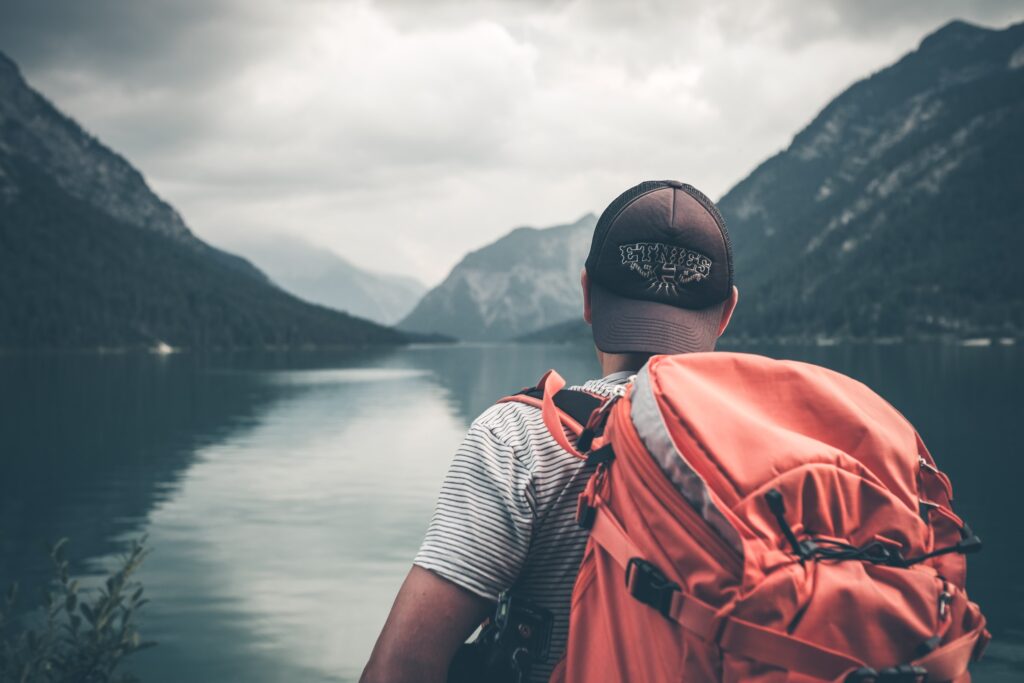
Despite the COVID-19 pandemic’s impact on travel, leisure tourism remains a popular choice for individuals looking to recharge and explore the world. From exploring famous landmarks in Paris to sunbathing on the beaches of Bali, there are countless examples of leisure tourism destinations and activities available worldwide. In this article, we will explore the concept of leisure tourism and provide several examples of popular destinations and activities you can add to your travel bucket list.
What is leisure travel?
Leisure travel refers to traveling for pleasure rather than business or work-related purposes. It is a type of travel that involves exploring new destinations, engaging in recreational activities, and relaxing and unwinding. Whether traveling alone or with friends and family, leisure travel provides a much-needed break from the daily routine and allows individuals to experience new cultures, environments, and experiences.
For the person traveling, leisure travel can provide a wide range of benefits, including learning about different cultures, making new friends, and creating lasting memories. It can also provide a sense of adventure, challenge, and excitement that can be hard to find in everyday life. Additionally, leisure travel can help reduce stress levels and improve mental health by providing a break from the daily routine.
As a tourist, leisure travel can also significantly impact the environment and local communities. Responsible tourism practices, such as supporting local businesses, using eco-friendly transportation, and being mindful of waste, can help minimize negative impacts and promote sustainable tourism.
Of course, finances are an essential consideration for leisure travel. Depending on the destination, activities, and accommodations chosen, leisure travel can be a costly endeavor. However, with careful planning, budgeting, and research, it is possible to enjoy leisure travel without breaking the bank. Many travel websites and apps offer discounts and deals on flights, hotels, and activities, making planning an affordable and enjoyable leisure travel experience easier than ever.
Types of leisure tourism
Adventure tourism.
One of the most popular types of adventure tourism is extreme sports. From bungee jumping to skydiving, there’s no shortage of heart-pumping activities to get your adrenaline flowing. These experiences are not for the faint of heart, but they offer a rush like no other and can be incredibly rewarding for those who take the plunge.
For those who prefer a slower pace, there are plenty of other adventure tourism options. Hiking, camping, and backpacking are all popular choices that allow you to explore the great outdoors and connect with nature. Whether traversing rugged mountain trails or pitching a tent in a remote wilderness area, these activities offer a chance to escape the hustle and bustle of everyday life and immerse yourself in the beauty of the natural world.
Of course, adventure tourism is only for some. Some people prefer to stick to more traditional types of leisure tourism, such as beach vacations or city breaks. However, you love a challenge and aren’t afraid to step outside your comfort zone. In that case, adventure tourism can be an incredibly rewarding and life-changing experience.
So, whether you’re looking to bungee jump off a bridge, hike through the wilderness, or explore a new city on foot, there’s an adventure tourism experience that’s perfect for you. So why not take the leap and try something new? You never know what amazing experiences and memories you might create!
Cultural tourism
One of the most exciting things about cultural tourism is that it can take you to places you never imagined. Whether exploring ancient ruins in Greece, visiting museums in Paris, or attending festivals in Japan, there are countless opportunities to learn and grow through cultural tourism.
Of course, cultural tourism doesn’t have to take you to far-flung destinations. There are plenty of opportunities to explore different cultures closer to home, whether visiting museums and art galleries, attending cultural events in your city, or trying new foods at ethnic restaurants.
For those who love to travel, cultural tourism offers a chance to see the world differently. Rather than just ticking off tourist attractions, cultural tourism allows you to connect with locals, learn about their way of life, and gain a deeper appreciation for the rich diversity of our planet.
So whether you’re a history buff, an art lover, or simply someone who wants to experience something new, cultural tourism has something for everyone. So why not step out of your usual environment and immerse yourself in the rich tapestry of cultures that make our world so fascinating? Who knows what incredible experiences and memories await you along the way!
Suppose you’re someone who cares deeply about the environment and wants to make a positive impact on the world. In that case, ecotourism might be the perfect choice for your next leisure tourism adventure. This tourism category is all about traveling responsibly and sustainably, focusing on preserving natural habitats and supporting local communities.
One of the main things to consider when it comes to ecotourism is your travel’s impact on the environment. This means choosing eco-friendly accommodations and activities, such as staying in lodges that use renewable energy, participating in wildlife conservation efforts, and using low-impact transportation methods like hiking or cycling.
Another important factor to consider is your travel’s impact on the local community. Ecotourism aims to support local economies and promote cultural exchange, so it’s important to choose tours and activities led by local guides and support local businesses.
Of course, ecotourism is not just about being responsible and sustainable – it’s also about having fun and experiencing the beauty of nature. Whether you’re exploring pristine forests, snorkeling in coral reefs, or observing wildlife in their natural habitats, there’s no shortage of amazing experiences to be had in ecotourism.
Suppose you’re passionate about the environment and want to positively impact the world while having fun and exploring new places. In that case, ecotourism might be the perfect fit for you. And as the tourism industry continues to grow and evolve, there are plenty of opportunities for jobs and careers in eco-tourism, making it a great choice for those who want to make a difference while pursuing their passions.
Beach tourism
Beach tourism is leisure tourism that revolves around visiting coastal destinations and enjoying the beach environment. This type of tourism is popular among people of all ages, from families with young children to solo travelers seeking relaxation and recreation.
Beach tourism destinations vary widely, from crowded beaches in popular tourist hotspots to secluded and pristine shorelines in remote locations. Some of the most popular beach tourism destinations include the Caribbean, Hawaii, the Maldives, and the Mediterranean.
Activities commonly associated with beach tourism include swimming, sunbathing, beach volleyball, surfing, and water sports such as jet skiing, parasailing, and snorkeling. Many beach tourism destinations also offer a range of amenities, such as beachfront restaurants, bars, cafes, and hotels and resorts catering to beachgoers.
Beach tourism can be a great way to escape the stresses of everyday life and enjoy some time in the sun and sand. It offers many experiences, from relaxing and soaking up the sun to more active pursuits such as water sports and beach games. For those who love the ocean and the beach environment, beach tourism is a must-try type of leisure tourism.
Health and wellness tourism
Health and wellness tourism is a type of leisure tourism that focuses on improving physical, mental, and emotional well-being through various activities and services. It involves traveling to destinations that offer specialized programs and services to help visitors achieve their health and wellness goals.
Some of the most common health and wellness tourism activities include spa treatments, yoga and meditation classes, fitness activities, healthy eating, and alternative medicine practices such as acupuncture and herbal remedies. Health and wellness tourism destinations can range from specialized wellness centers and retreats to traditional vacation spots that offer a variety of wellness-focused activities and services.
Health and wellness tourism has become increasingly popular in recent years as more people seek to prioritize their health and well-being. This type of tourism offers a range of benefits, including stress relief, improved physical health, and a renewed sense of energy and vitality.
In addition to the benefits for individual travelers, health and wellness tourism can also positively impact local communities. It can create job opportunities in the wellness industry and stimulate local economies through increased tourism.
Overall, health and wellness tourism is a great option for those seeking to prioritize their health and well-being while enjoying leisure travel’s benefits. With a wide range of activities and services available, there is something for everyone in the world of health and wellness tourism.
Can business travelers have leisure time on a business trip?
Yes, business travelers can have leisure time on a business trip, depending on their schedule and the purpose of their trip. Many business travelers often have free time during their trip, either before or after their work obligations are completed. During this time, they may choose to engage in leisure activities and explore the destination they are visiting.
Business travelers may also extend their trip for a few days or a weekend to have more time to explore the destination and engage in leisure activities. This is often called “bleisure” travel, a combination of business and leisure travel.
However, it is important to note that the amount of leisure time a business traveler can have may depend on the nature of their business trip and the expectations of their employer. Sometimes, the schedule may be tightly packed with meetings, and there may be little free time for leisure activities. Additionally, some employers may have policies restricting the amount of leisure time a business traveler can have or the type of activities they can engage in during their free time.
Ultimately, it is up to the individual business traveler to determine how much leisure time they can have on a business trip and to balance their work obligations with their desire to explore and engage in leisure activities.
What are the examples of leisure tourism?
There are many examples of leisure tourism, as it encompasses many activities and destinations. Some examples of leisure tourism include:
- Beach tourism – visiting coastal destinations for sun, sand, and water activities.
- Adventure tourism – engaging in activities such as hiking, skiing, and whitewater rafting in natural environments.
- Cultural tourism – visiting destinations to learn about the local culture, history, and customs.
- Health and wellness tourism – traveling to destinations that offer specialized programs and services to improve physical, mental, and emotional well-being.
- Ecotourism – visiting natural environments to observe and learn about the local flora and fauna while minimizing environmental impact.
- Rural tourism – visiting rural destinations to experience rural life and engage in farming, fishing, and hunting activities.
- Wine tourism is visiting destinations known for their wine production and touring vineyards and wineries.
- Sports tourism – traveling to participate in or observe events such as marathons, golf tournaments, and soccer matches.
- Food tourism – traveling to destinations to experience local cuisine and food traditions.
- Educational tourism is traveling to destinations to learn about specific subjects, such as art, history, or language.
These are just a few examples of leisure tourism, and many other types of tourism can fall under this category. Ultimately, leisure tourism is about enjoying the free time and engaging in activities that provide relaxation, entertainment, and personal enrichment.
In conclusion, leisure tourism encompasses various activities and destinations, from beaches to educational tourism. The purpose of leisure tourism is to provide individuals with opportunities for relaxation, entertainment, and personal enrichment. People engage in leisure tourism to escape from their usual environment, explore new destinations, and engage in activities that they enjoy or that interest them.
While there are many types of leisure tourism, all of them share a common goal of providing individuals with a break from their daily routines and an opportunity to have fun and create memorable experiences. As the tourism industry continues to grow and evolve, we can expect to see new types of leisure tourism emerge, and existing types become more popular.
Ultimately, leisure tourism plays an important role in the tourism industry and the lives of individuals who engage in it. It provides opportunities for personal growth, cultural exchange, and economic development. Whether it’s a relaxing beach vacation, an adventurous trek through the wilderness, or an educational trip to a historic site, leisure tourism has something to offer everyone.
David Stokes
Related posts.

8 Hacks to Never pay for Luggage
- March 24, 2023

Smart Hacks to Book Cheap Flights in 2023
- March 22, 2023
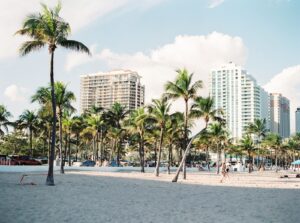
8 Famous Cities in the USA You Must Visit
- March 3, 2023
Trending now

What Is Leisure Travel and Why Is It Important?
Leisure Travel: An
Have you ever wondered why people travel? Sure, there are the obvious reasons, like seeing new places and experiencing different cultures. But there’s something more to it than that. For many people, travel is a way to relax and escape from the stresses of everyday life. It’s a chance to recharge and come back home feeling refreshed and rejuvenated.
Leisure travel is any type of travel that is done for pleasure rather than for business or other obligations. It can include everything from a weekend getaway to a month-long backpacking trip. And it can be done anywhere in the world, from your own backyard to the most exotic destinations.
No matter where you go or what you do, leisure travel is a great way to broaden your horizons and learn about new cultures. It’s also a great way to meet new people and make new friends. And most importantly, it’s a great way to have fun and create memories that will last a lifetime.
In this article, we’ll take a closer look at leisure travel. We’ll discuss the different types of leisure travel, the benefits of travel, and how to plan your next trip. So whether you’re a seasoned traveler or you’re just starting out, read on for some helpful tips and advice.
What is Leisure Travel?
Leisure travel is travel undertaken for pleasure or relaxation. It is a type of tourism that is distinct from business travel, which is undertaken for work-related purposes. Leisure travel can take many forms, from a weekend trip to a beach to a multi-month backpacking expedition.
Leisure travel is a popular activity for many people, as it offers a chance to escape from the stresses of everyday life and to experience new things. It can also be a way to learn about different cultures and to meet new people.
Types of Leisure Travel
There are many different types of leisure travel, each with its own unique appeal. Some of the most popular types of leisure travel include:
- Domestic travel is travel within one’s own country. This can include visiting cities, towns, and attractions within the country, as well as taking road trips or camping trips.
- International travel is travel to a different country. This can include visiting major cities, exploring smaller towns and villages, or taking part in adventure activities.
- Adventure travel is travel that involves physical challenges or activities, such as hiking, biking, skiing, or rafting. Adventure travel can be a great way to see new places and to push yourself physically and mentally.
- Cultural travel is travel that focuses on learning about different cultures. This can include visiting museums, taking cooking classes, or attending cultural events. Cultural travel can be a great way to broaden your horizons and to learn about different ways of life.
- Ecotourism is travel that is designed to minimize the impact on the environment. This can include staying in eco-friendly accommodations, eating locally-sourced food, and using sustainable transportation. Ecotourism can be a great way to learn about the natural environment and to help protect it.
- Wellness travel is travel that focuses on improving one’s physical and mental health. This can include visiting spas, taking yoga classes, or getting massages. Wellness travel can be a great way to relax and to de-stress.
- Educational travel is travel that is designed to learn about a particular subject. This can include taking courses at a university or college, visiting historical sites, or meeting with experts. Educational travel can be a great way to learn about new things and to expand your horizons.
- Volunteer travel is travel that involves volunteering your time to help others. This can include working with animals, teaching English, or building houses. Volunteer travel can be a great way to give back to the community and to make a difference in the world.
Benefits of Leisure Travel
Leisure travel has many benefits for both the individual and the community. Some of the benefits of leisure travel include:
- Physical and mental health benefits: Leisure travel can help to improve physical and mental health. It can reduce stress, improve mood, and boost energy levels. Leisure travel can also help to improve sleep quality and to reduce the risk of chronic diseases.
- Cultural and educational benefits: Leisure travel can help to broaden one’s horizons and to learn about different cultures. It can also provide opportunities to learn about new languages, history, and customs.
- Social and relationship benefits: Leisure travel can help to strengthen social relationships and to build new friendships. It can also be a great way to reconnect with family and friends.
- Economic benefits: Leisure travel can help to boost the economy by creating jobs and stimulating tourism. It can also help to promote international understanding and cooperation.
Leisure travel is a popular activity that offers many benefits for both the individual and the community. It is a great way to escape from the stresses of everyday life, to learn about new things, to meet new people, and to make a difference in the world.
What Is Leisure Travel?
Leisure travel is travel undertaken for pleasure or relaxation. It is often contrasted with business travel, which is travel undertaken for work purposes. Leisure travel can take many forms, from a weekend getaway to a month-long vacation. It can be done by car, plane, train, or boat. And it can be taken to any destination in the world.
There are many reasons why people choose to travel for leisure. Some people travel to experience new cultures and meet new people. Others travel to learn about history or nature. And still others travel simply to relax and have fun.
No matter what your reason for traveling, leisure travel can be a rewarding experience. It can help you to broaden your horizons, learn new things, and make memories that will last a lifetime.
Planning a Leisure Trip
Planning a leisure trip can be a fun and exciting experience. However, it can also be a lot of work. To make the most of your trip, it is important to do your research and plan ahead.
Here are some tips for planning a leisure trip:
- Set a budget. The first step in planning a trip is to set a budget. This will help you to determine how much you can spend on airfare, lodging, food, and other expenses.
- Choose a destination. Once you have a budget in mind, you can start to choose a destination. There are many factors to consider when choosing a destination, such as your interests, budget, and travel time.
- Book transportation and accommodations. Once you have chosen a destination, you need to book transportation and accommodations. This can be done online or through a travel agent.
- Get travel insurance. It is always a good idea to get travel insurance when you are traveling internationally. This will protect you in case of cancellations, medical emergencies, or lost luggage.
- Prepare for your trip. In the weeks leading up to your trip, you should start to prepare for your trip. This includes packing your bags, getting your passport and visas, and updating your vaccinations.
By following these tips, you can plan a leisure trip that is both enjoyable and affordable.
Travel Safety
When you are traveling for leisure, it is important to stay safe. Here are some tips for staying safe while traveling:
- Be aware of your surroundings. Be aware of your surroundings at all times, especially when you are in unfamiliar places. Pay attention to people who are following you or who seem suspicious.
- Don’t leave your belongings unattended. Never leave your belongings unattended, especially in crowded areas. If you have to leave your belongings, make sure they are in a safe place.
- Be careful about what you eat and drink. Be careful about what you eat and drink when you are traveling. Avoid eating food from street vendors or drinking tap water.
- Stay aware of local laws and customs. Before you travel, make sure you are aware of the local laws and customs. This will help you to avoid any problems.
By following these tips, you can stay safe while traveling for leisure.
Leisure travel can be a wonderful way to experience new cultures, meet new people, and learn new things. By following these tips, you can plan a leisure trip that is both enjoyable and affordable. And by staying safe, you can ensure that your trip is a success.
What is leisure travel?
Leisure travel is travel that is done for pleasure rather than for business or other purposes. It can include activities such as visiting tourist attractions, relaxing on a beach, or taking part in sports or other recreational activities.
What are the benefits of leisure travel?
There are many benefits to leisure travel, including:
- Relaxation: Leisure travel can help you to relax and de-stress from the stresses of everyday life.
- Exploration: Leisure travel can allow you to explore new places and cultures, and learn about different ways of life.
- Social interaction: Leisure travel can provide you with opportunities to meet new people and make new friends.
- Improved health: Leisure travel can help to improve your health and well-being by getting you out of your usual routine and providing you with opportunities to exercise and be active.
What are some popular destinations for leisure travel?
Some of the most popular destinations for leisure travel include:
- Beaches: Beaches are a popular destination for leisure travel, as they offer the opportunity to relax and enjoy the sun, sand, and surf. Some of the most popular beach destinations include the Caribbean, Hawaii, and the Mediterranean.
- Cities: Cities are also popular destinations for leisure travel, as they offer a variety of attractions, such as museums, theaters, and restaurants. Some of the most popular city destinations include London, Paris, and New York City.
- National parks: National parks are another popular destination for leisure travel, as they offer the opportunity to explore natural wonders, such as mountains, forests, and deserts. Some of the most popular national park destinations include Yellowstone National Park, Yosemite National Park, and the Grand Canyon.
How can I plan a leisure travel trip?
Planning a leisure travel trip can be a fun and rewarding experience. Here are a few tips to help you get started:
- Set a budget: The first step is to set a budget for your trip. This will help you to narrow down your options and make the most of your money.
- Choose a destination: Once you have a budget in mind, you can start to choose a destination for your trip. Consider your interests and budget when making your decision.
- Book your transportation: Once you have chosen a destination, you will need to book your transportation. This may include flights, trains, or buses.
- Book your accommodations: You will also need to book your accommodations. This may include hotels, hostels, or Airbnbs.
- Create an itinerary: Once you have booked your transportation and accommodations, you can start to create an itinerary for your trip. This will help you to make the most of your time and see all of the sights that you want to see.
What are some common mistakes to avoid when planning a leisure travel trip?
There are a few common mistakes that people make when planning a leisure travel trip. These include:
- Not setting a budget: One of the biggest mistakes that people make is not setting a budget for their trip. This can lead to overspending and stress.
- Not doing enough research: Another common mistake is not doing enough research on your destination. This can lead to missed opportunities and disappointments.
- Not being flexible: It is important to be flexible when planning a leisure travel trip. Things can change, so it is important to be able to adapt to unexpected circumstances.
By avoiding these common mistakes, you can help to ensure that your leisure travel trip is a success.
leisure travel is a vast and varied industry that offers something for everyone. Whether you’re looking to relax on a beach, explore a new city, or learn about a different culture, there’s a leisure travel experience out there for you.
When planning your next leisure travel adventure, be sure to do your research and choose a destination that’s right for you. Consider your interests, budget, and time constraints, and make sure to book your trip well in advance. With a little planning, you can have the vacation of a lifetime.
Here are some key takeaways from this article:
- Leisure travel is a broad term that can encompass a variety of activities, including sightseeing, shopping, dining, and cultural exploration.
- Leisure travel can be a great way to relax, learn about new cultures, and make new memories.
- When planning your next leisure travel adventure, be sure to do your research and choose a destination that’s right for you.
Author Profile

Latest entries
- January 19, 2024 Hiking How to Lace Hiking Boots for a Perfect Fit
- January 19, 2024 Camping How to Dispose of Camping Propane Tanks the Right Way
- January 19, 2024 Traveling Information Is Buffalo Still Under Travel Ban? (Updated for 2023)
- January 19, 2024 Cruise/Cruising Which Carnival Cruise Is Best for Families?
Winter is here! Check out the winter wonderlands at these 5 amazing winter destinations in Montana
- Travel Tips
What Does Leisure And Tourism Mean
Published: December 12, 2023
Modified: December 28, 2023
by Karna Choi
- Plan Your Trip
- Sustainability
Introduction
Leisure and tourism are two interconnected concepts that play a significant role in our lives. They are not only sources of relaxation and entertainment but also contribute to the growth of economies and the development of cultures. In this article, we will explore what leisure and tourism mean, how they are related, and why they are important.
Leisure refers to the time spent outside of work or other commitments, where individuals engage in activities that they enjoy and find fulfilling. It can be any activity that brings pleasure, such as hobbies, sports, reading, or socializing with friends and family. Leisure is crucial for maintaining a healthy work-life balance and overall well-being. It allows individuals to rejuvenate, recharge, and engage in activities that bring them joy and satisfaction.
Tourism, on the other hand, involves traveling to different places for recreational, educational, or business purposes. It is an industry that encompasses a wide range of activities, such as sightseeing, visiting cultural and historical sites, exploring natural wonders, participating in adventure sports, attending conferences, and experiencing different cuisines and lifestyles. Tourism provides an opportunity to discover new cultures, broaden horizons, and create lasting memories.
Definition of Leisure
Leisure can be defined as the discretionary time individuals have outside of their work and other necessary commitments. It is the time to engage in activities that bring joy, relaxation, and personal fulfillment. It provides a break from the daily routine and allows individuals to pursue their interests and passions.
Leisure activities can vary greatly depending on personal preferences and interests. Some individuals may find solace in engaging in physical activities such as swimming, hiking, or playing sports, while others may prefer more passive activities like reading, listening to music, or watching movies. Leisure can also include socializing with friends and family, exploring new hobbies, attending cultural events, or even simply resting and rejuvenating.
One important aspect of leisure is that it is not bound by obligations or tasks. It is a free and voluntary choice that individuals make to engage in activities that bring them pleasure and relaxation. Unlike work or other responsibilities, leisure provides a sense of freedom and autonomy, allowing individuals to make choices based on their personal preferences and desires.
Leisure is essential for personal well-being and mental health. It helps individuals to de-stress, recharge, and maintain a healthy work-life balance. Engaging in leisure activities can have numerous benefits, including reducing anxiety and depression, improving cognitive functions, boosting creativity, and enhancing social connections.
It is important to note that leisure is subjective and can vary from person to person. What one individual finds enjoyable and fulfilling may not be the same for another. Therefore, it is crucial for individuals to identify activities that bring them joy and make time for those activities in their lives. By prioritizing leisure, individuals can enhance their overall quality of life and find a sense of fulfillment and happiness.
Definition of Tourism
Tourism is the act of traveling to different destinations for recreational, educational, or business purposes. It involves the exploration and experience of new places, cultures, and activities outside one’s usual environment. Tourism is a multi-faceted industry that encompasses various activities and services, including transportation, accommodation, attractions, and hospitality.
The primary motive behind tourism is usually leisure and entertainment. People travel to escape their daily routines, experience new things, and create lasting memories. However, tourism can also serve other purposes, such as business travel, educational or cultural exchanges, and even medical tourism for specialized treatments.
There are several different types of tourism, each catering to specific interests and preferences. Some of the common types include:
- Leisure tourism: This involves traveling for recreational purposes, such as beach vacations, adventure trips, or visiting theme parks.
- Cultural tourism: This focuses on exploring the heritage, customs, and traditions of different cultures, including visiting museums, historical sites, and attending cultural events.
- Eco-tourism: This promotes responsible travel to natural areas, with the aim of preserving the environment and supporting local communities.
- Business tourism: This involves traveling for business-related activities, such as attending conferences, meetings, or trade shows.
- Medical tourism: This refers to traveling to foreign countries to receive medical treatments or procedures that may be more affordable or of higher quality than in one’s home country.
Tourism plays a vital role in the global economy, contributing to employment generation, infrastructure development, and foreign exchange earnings. It stimulates local businesses, such as hotels, restaurants, and transportation services, creating a multiplier effect on the economy. Moreover, tourism has the potential to foster cultural exchange and understanding between different societies, promoting peace and mutual respect.
However, it is important to note that tourism can also have negative impacts, including over-tourism, environmental degradation, and disruption of local communities. Sustainable tourism practices are increasingly emphasized to minimize these negative effects and ensure the long-term viability of tourist destinations.
Relationship between Leisure and Tourism
Leisure and tourism share a close and interconnected relationship. While leisure refers to the activities individuals engage in during their free time, tourism provides an avenue for individuals to experience leisure in different locations and environments. In other words, tourism is one of the ways in which people seek leisure experiences beyond their usual surroundings.
Tourism encompasses a wide range of activities and experiences that are specifically designed to provide leisure and entertainment. When individuals go on vacation or travel to different destinations, they often engage in leisure activities as part of their overall tourism experience. This may include exploring tourist attractions, trying new foods, participating in adventure sports, or simply relaxing on a beach.
On the other hand, leisure can also act as a motivator for individuals to engage in tourism. People often plan trips or vacations to unwind, break away from their daily routines, and indulge in leisure activities that they may not have the opportunity to enjoy in their regular lives. The desire for leisure experiences can inspire individuals to embark on travel adventures and explore new destinations.
Furthermore, leisure and tourism can also have a reciprocal relationship, where they reinforce and support each other. For instance, the availability of leisure activities in a tourist destination can attract visitors and contribute to the growth of the tourism industry. Similarly, tourism development can lead to the creation of new leisure facilities and opportunities for both locals and visitors to enjoy.
The relationship between leisure and tourism is not limited to individual experiences but also extends to the societal level. The leisure and tourism industries collectively contribute to the economic growth of countries, generate employment opportunities, and stimulate local businesses. They also play a significant role in cultural exchange and understanding as individuals from different cultures engage in leisure and tourism activities together.
It is important to recognize and foster the relationship between leisure and tourism to cater to the diverse needs and desires of travelers. Tourism destinations and businesses often strive to provide a variety of leisure activities and experiences that appeal to different interests and preferences, ensuring that visitors can engage in meaningful and enjoyable leisure during their trips.
Importance of Leisure and Tourism
Leisure and tourism play a crucial role in both individual lives and the broader society. They provide numerous benefits and contribute significantly to personal well-being, economic growth, and cultural exchange. Here are some key reasons why leisure and tourism are important:
1. Personal Well-Being: Leisure activities give individuals the opportunity to relax, recharge, and engage in activities they enjoy. They help reduce stress, promote mental health, and enhance overall well-being. Leisure activities provide a sense of fulfillment, satisfaction, and happiness, allowing individuals to maintain a healthy work-life balance.
2. Economic Impact: The leisure and tourism industries have a substantial impact on economies worldwide. They create jobs, stimulate local businesses, and generate revenue through various sectors such as accommodation, transportation, food and beverage, and entertainment. Tourism also encourages infrastructure development, leading to improvements in transportation, communication, and public facilities.
3. Cultural Exchange: Tourism fosters cultural exchange by bringing people from different backgrounds together. Visitors have the opportunity to experience different traditions, customs, and ways of life, promoting understanding and appreciation of diverse cultures. Additionally, locals in tourism destinations can share their heritage and showcase their culture, which helps in preserving and celebrating their identity.
4. Environmental Preservation: Sustainable tourism practices promote the protection and conservation of natural resources and ecosystems. By emphasizing responsible travel and minimizing the negative impacts on the environment, tourism can contribute to the preservation of biodiversity and the overall health of our planet. Eco-tourism initiatives also support environmental education and local conservation efforts.
5. Educational Opportunities: Tourism provides opportunities for educational experiences. Visitors can learn about history, art, architecture, and other aspects of different cultures through museum visits, guided tours, and cultural events. Educational tourism can also include attending workshops, language classes, or participating in immersive experiences that help broaden knowledge and perspective.
6. Community Development: Tourism can play a significant role in community development, especially in less-developed areas. It creates employment opportunities and income streams for locals, which can improve their living standards. Additionally, tourism can help revitalize and preserve traditional industries, handicrafts, and cultural practices, supporting the sustainability of local communities.
Types of Leisure Activities
Leisure activities encompass a wide range of pursuits that individuals engage in during their free time. These activities serve as a means of relaxation, entertainment, and personal fulfillment. Here are some common types of leisure activities:
- Physical Activities: Engaging in physical activities is a popular form of leisure. This can include sports such as soccer, basketball, tennis, or swimming. Physical activities not only promote physical fitness but also provide an outlet for stress relief and a sense of accomplishment.
- Creative Pursuits: Many individuals find pleasure and fulfillment in creative leisure activities. This can include painting, drawing, writing, playing a musical instrument, or engaging in crafts such as knitting or woodworking. The act of creating something allows individuals to express themselves, tap into their imagination, and experience a sense of accomplishment.
- Socializing: Connecting with others is a fundamental aspect of leisure. Socializing can take various forms, such as meeting friends for a coffee or a meal, attending social events or parties, or participating in group activities like book clubs or sports teams. Engaging in social activities provides an opportunity for building relationships, sharing experiences, and fostering a sense of belonging.
- Exploring Nature: Many people find solace and rejuvenation in spending time in nature. Activities such as hiking, camping, birdwatching, or gardening allow individuals to connect with the natural world, experience tranquility, and appreciate the beauty of their surroundings. Outdoor leisure activities also contribute to physical fitness and overall well-being.
- Reading and Learning: Reading books, magazines, or articles is a favorite leisure activity for many. It allows individuals to escape into different worlds, expand their knowledge, and stimulate their imagination. Additionally, engaging in lifelong learning, whether through online courses, workshops, or educational programs, is a fulfilling leisure pursuit that promotes personal growth and intellectual development.
- Travel and Adventure: Exploring new places and embarking on travel adventures is a popular form of leisure. Whether it’s a weekend getaway to a nearby city or an international trip to a distant country, travel allows individuals to experience new cultures, cuisines, and landscapes. Adventure activities such as rock climbing, bungee jumping, or skydiving also provide an exhilarating form of leisure for thrill-seekers.
- Relaxation and Mindfulness: In today’s fast-paced world, relaxation and mindfulness activities are essential for mental well-being. These can include meditation, yoga, spa treatments, or taking soothing baths. Engaging in relaxation and mindfulness practices helps individuals to unwind, reduce stress levels, and achieve a state of inner calm.
Types of Tourism Activities
Tourism activities encompass a wide range of experiences and opportunities for travelers to engage in during their journeys. These activities cater to diverse interests and preferences, ensuring that individuals can immerse themselves in unique and memorable experiences. Here are some common types of tourism activities:
- Sightseeing and Cultural Exploration: One of the most popular tourism activities is sightseeing and exploring different cultures. This involves visiting famous landmarks, historical sites, museums, and cultural attractions. Travelers have the opportunity to learn about the history, art, and traditions of a particular destination, allowing for a deeper understanding of its heritage and identity.
- Nature and Adventure Tourism: For those seeking outdoor adventures and natural wonders, nature and adventure tourism is an ideal choice. Activities such as hiking, trekking, wildlife safaris, snorkeling, or zip-lining allow travelers to explore pristine landscapes, encounter unique flora and fauna, and experience adrenaline-pumping thrills.
- Beach and Resort Tourism: Many tourists are drawn to destinations with beautiful beaches and world-class resorts. Beach tourism offers relaxation, swimming, sunbathing, and water sports such as surfing, snorkeling, or jet skiing. Resorts provide luxurious accommodations, spa facilities, and a range of recreational activities for a truly indulgent vacation.
- Culinary and Food Tourism: Food enthusiasts often embark on culinary tourism, where they explore the local cuisine and indulge in gastronomic experiences. This can involve food tours, cooking classes, visiting food markets, or dining at renowned restaurants to savor authentic flavors and regional specialties.
- Heritage and Architectural Tourism: Heritage and architectural tourism focus on exploring historical buildings, monuments, and architectural gems. This can involve visiting ancient ruins, castles, temples, or exploring preserved historic neighborhoods. Travelers can appreciate the craftsmanship and cultural significance of these structures.
- Eco-tourism and Sustainable Tourism: With a growing focus on sustainability, eco-tourism has gained popularity. It involves responsible travel to natural areas, promoting conservation and sustainable practices. Activities can include wildlife conservation projects, eco-lodges, hiking in national parks, and participating in environmental education programs.
- Adventure and Extreme Tourism: Adventure-seekers often pursue extreme tourism activities that push their limits. This can include activities such as skydiving, bungee jumping, white-water rafting, paragliding, or mountain climbing. These adrenaline-pumping experiences provide a thrill and unique sense of achievement.
- Wellness and Health Tourism: Wellness tourism focuses on enhancing physical and mental well-being. Travelers can indulge in spa retreats, yoga and meditation retreats, detox programs, or health resorts. These activities promote relaxation, rejuvenation, and self-care.
Benefits of Leisure and Tourism
Leisure and tourism bring numerous benefits to individuals, communities, and societies as a whole. These benefits encompass various aspects of personal, economic, cultural, and environmental well-being. Here are some key advantages of leisure and tourism:
- Personal Well-being: Leisure and tourism activities contribute to personal well-being by providing opportunities for relaxation, stress relief, and enjoyment. Engaging in leisure activities helps individuals maintain a healthy work-life balance, reduce anxiety and depression, improve mood, and enhance overall mental and physical health.
- Cultural Exchange: Tourism promotes cultural exchange and understanding between people from different backgrounds. Visitors have the opportunity to immerse themselves in local cultures, traditions, and customs. This fosters mutual respect, broadens perspectives, and breaks down stereotypes, contributing to a more harmonious and interconnected world.
- Economic Growth and Job Creation: The leisure and tourism industries have a significant impact on economies. They generate employment across various sectors, such as hospitality, transportation, and tourism services. Tourism also creates business opportunities for local entrepreneurs, stimulates infrastructure development, and generates revenue through visitor spending.
- Preservation of Natural and Cultural Heritage: Tourism plays a vital role in the preservation and conservation of natural and cultural heritage. It provides the necessary funds for the maintenance of historical sites, museums, national parks, and protected areas. Additionally, responsible tourism practices promote sustainability, environmental awareness, and the protection of delicate ecosystems.
- Community Development: Leisure and tourism contribute to community development in various ways. Local communities benefit from increased job opportunities, business growth, and infrastructure development. Tourism can also help revitalize traditional industries, preserve local crafts and cultural practices, and provide a platform for showcasing and celebrating local heritage and identity.
- Education and Learning: Leisure and tourism provide educational opportunities for travelers. Visiting museums, historical sites, and cultural attractions can enhance knowledge and understanding of different cultures, history, art, and architecture. Beyond formal education, tourism allows for experiential learning, providing insights into different ways of life and fostering personal growth and development.
- Quality of Life: Leisure and tourism contribute to an improved quality of life for individuals and communities. By providing opportunities for leisure and travel experiences, people can create lasting memories, build meaningful relationships, and pursue personal interests and hobbies. This leads to increased life satisfaction, happiness, and a sense of fulfillment.
Challenges in the Leisure and Tourism Industry
The leisure and tourism industry faces various challenges that can impact its sustainability, growth, and overall success. These challenges arise from internal and external factors, and the industry must navigate them effectively to thrive. Here are some key challenges in the leisure and tourism industry:
- Seasonality: Many tourism destinations experience significant fluctuations in visitor arrivals due to seasonal patterns. This creates a challenge in maintaining a stable flow of tourists and generating consistent revenue throughout the year. Destinations heavily reliant on specific seasons may struggle economically during off-peak periods.
- Changing Consumer Preferences: The leisure and tourism industry must constantly adapt to evolving consumer preferences. As travelers become more discerning, their demands and expectations shift. Meeting these changing preferences requires continuous innovation, investment in infrastructure, and ensuring high-quality service delivery.
- Competition: The leisure and tourism industry is highly competitive. Destinations and businesses must differentiate themselves and offer unique experiences to attract visitors. Furthermore, competition in the digital space has intensified with the rise of online travel agencies and platforms, making it necessary to have a strong online presence and effective marketing strategies.
- Security and Safety Concerns: Ensuring the safety and security of travelers is of paramount importance. Natural disasters, political instability, terrorism, and other security concerns can significantly impact tourism. Effective crisis management, stringent security measures, and proactive communication are essential to manage and mitigate such risks.
- Sustainable Practices: As environmental awareness grows, the leisure and tourism industry faces the challenge of adopting sustainable practices. Balancing tourism development with environmental protection is crucial to preserve destinations and minimize the industry’s ecological footprint. This involves minimizing waste, promoting responsible tourism, and supporting local communities.
- Infrastructure and Accessibility: Developing and maintaining adequate infrastructure can be a challenge, particularly in remote and less-developed areas. The lack of transportation networks, accommodation options, and tourist facilities can hinder tourism growth. Ensuring accessibility is crucial to attract and cater to a wide range of travelers.
- Social and Cultural Impacts: The influx of tourists can have both positive and negative impacts on local communities. Over-tourism can strain resources, cause cultural commodification, and disrupt traditional lifestyles. Finding the right balance between tourism development and preserving local cultures and identities presents a challenge.
The leisure and tourism industry must proactively address these challenges to sustain its growth and ensure long-term success. Collaboration between stakeholders, effective destination management, continuous innovation, and responsible practices are key to overcoming these challenges and maintaining a vibrant and sustainable leisure and tourism industry.
Future Trends in Leisure and Tourism
The leisure and tourism industry is constantly evolving and adapting to the changing needs and preferences of travelers. As we look to the future, several trends are expected to shape the industry and redefine the way people engage in leisure and travel. Here are some key future trends in leisure and tourism:
- Sustainable and Responsible Tourism: There is a growing emphasis on sustainable and responsible tourism practices. Travelers are increasingly seeking eco-friendly and socially conscious experiences. Future trends will focus on reducing carbon footprints, preserving natural and cultural heritage, and supporting local communities.
- Technology Integration: Technology will continue to play a significant role in the leisure and tourism industry. Advancements in virtual reality, augmented reality, and artificial intelligence will enhance the overall travel experience. Technologies such as mobile apps, digital assistants, and smart devices will streamline processes and provide personalized recommendations to travelers.
- Experience-based Travel: Travelers are shifting towards a more experiential approach to travel. They seek immersive and authentic experiences that go beyond traditional sightseeing. Future trends will focus on curated experiences such as culinary tours, cultural workshops, adventure activities, and opportunities for meaningful connections with local communities.
- Wellness and Health Tourism: The importance of well-being and self-care is on the rise. Wellness tourism will continue to gain momentum, with travelers seeking destinations and experiences that promote relaxation, mental health, and physical fitness. Spas, yoga retreats, wellness resorts, and mindfulness activities will be in high demand.
- Customization and Personalization: Travelers are increasingly seeking personalized and tailored experiences. Future trends will focus on customization, allowing individuals to curate their itineraries based on their preferences and interests. Technology will play a crucial role in enabling personalized recommendations and immersive experiences.
- Multi-generational Travel: With longer life expectancy and changing family dynamics, multi-generational travel is becoming more popular. Families are seeking destinations and activities that cater to different age groups, ensuring a memorable experience for everyone. Future trends will focus on providing diverse offerings and amenities suitable for all generations.
- Workation and Digital Nomadism: The rise of remote work and digital nomadism has led to the emergence of workation trends. Travelers are combining work and travel, seeking destinations that offer a balance between work and leisure activities. Future trends will see destinations catering to the needs of digital nomads, providing infrastructure, coworking spaces, and networking opportunities.
The leisure and tourism industry needs to adapt to these future trends to stay relevant and meet evolving customer demands. Embracing sustainability, leveraging technology, providing personalized experiences, and recognizing the changing dynamics of travel will be key to success in the future.
Leisure and tourism are intertwined concepts that have a profound impact on individuals, communities, and societies worldwide. They provide opportunities for relaxation, exploration, personal growth, and cultural exchange. The diversity of leisure activities and the range of tourism experiences cater to the varied interests and preferences of travelers, ensuring that there is something for everyone.
Leisure activities offer individuals a break from their daily routines, allowing them to nurture their well-being, pursue their passions, and connect with others. Whether engaging in physical activities, creative hobbies, socializing, or embracing nature, leisure provides essential outlets for self-expression, enjoyment, and personal fulfillment.
Tourism, on the other hand, enables individuals to venture beyond their familiar surroundings and immerse themselves in new cultures, environments, and experiences. It contributes to economic growth, job creation, and the preservation of natural and cultural heritage. Tourism fosters intercultural understanding, promoting peace and harmony while supporting the development of local communities.
However, the leisure and tourism industry also faces challenges that require careful navigation and proactive management. Seasonality, changing consumer preferences, competition, security concerns, sustainable practices, and infrastructure development all present obstacles that need to be tackled for the industry’s sustainability and success.
Looking to the future, the leisure and tourism industry will continue to evolve and adapt to emerging trends. From sustainable and responsible tourism practices to technology integration, experiential travel, and wellness tourism, the industry will cater to the changing needs and desires of travelers. Customization, multi-generational travel, workation, and digital nomadism will shape the way individuals engage in leisure and travel, emphasizing personalization and flexibility.
In conclusion, leisure and tourism are integral parts of our lives. They promote personal well-being, economic growth, cultural exchange, and environmental preservation. By embracing the diverse range of leisure activities and promoting responsible tourism practices, we can create a more inclusive and sustainable world, where individuals can find joy, fulfillment, and connection through leisure and travel experiences.

- Privacy Overview
- Strictly Necessary Cookies
This website uses cookies so that we can provide you with the best user experience possible. Cookie information is stored in your browser and performs functions such as recognising you when you return to our website and helping our team to understand which sections of the website you find most interesting and useful.
Strictly Necessary Cookie should be enabled at all times so that we can save your preferences for cookie settings.
If you disable this cookie, we will not be able to save your preferences. This means that every time you visit this website you will need to enable or disable cookies again.
- English (CA)
- Deutsch (DE)
- Deutsch (CH)
8 types of tourism that you need to know
The three tourism categories, domestic tourism, inbound tourism, outbound tourism, the 8 types of tourism according to motivation, business tourism.
- Meet with business partners or prospects
- Attend an event, conference, or trade show
- Visit another office location of the same company
?)
See how to save money on business travel
Leisure tourism, shopping tourism, cultural tourism, sports tourism, rural tourism, mountain tourism, urban tourism, many people travel – but for completely different reasons.
?)
Make business travel simpler. Forever.
- See our platform in action . Trusted by thousands of companies worldwide, TravelPerk makes business travel simpler to manage with more flexibility, full control of spending with easy reporting, and options to offset your carbon footprint.
- Find hundreds of resources on all things business travel, from tips on traveling more sustainably, to advice on setting up a business travel policy, and managing your expenses. Our latest e-books and blog posts have you covered.
- Never miss another update. Stay in touch with us on social for the latest product releases, upcoming events, and articles fresh off the press.
?)
5 inefficient processes affecting your business and how to fix them
?)
Duty of care in the workplace: everything you need to know
?)
CEO Roles and Responsibilities: conquer your role as CEO
- Business Travel Management
- Offset Carbon Footprint
- Flexible travel
- Travelperk Sustainability Policy
- Corporate Travel Resources
- Corporate Travel Glossary
- For Travel Managers
- For Finance Teams
- For Travelers
- Thoughts from TravelPerk
- Careers Hiring
- User Reviews
- Integrations
- Privacy Center
- Help Center
- Privacy Policy
- Cookies Policy
- Modern Slavery Act | Statement
- Supplier Code of Conduct
Advertiser Disclosure
Many of the credit card offers that appear on this site are from credit card companies from which we receive financial compensation. This compensation may impact how and where products appear on this site (including, for example, the order in which they appear). However, the credit card information that we publish has been written and evaluated by experts who know these products inside out. We only recommend products we either use ourselves or endorse. This site does not include all credit card companies or all available credit card offers that are on the market. See our advertising policy here where we list advertisers that we work with, and how we make money. You can also review our credit card rating methodology .
What Is “Bleisure Travel” and How Can It Benefit You?
Senior Content Contributor
48 Published Articles
Countries Visited: 58 U.S. States Visited: 40
Editor & Content Contributor
150 Published Articles 746 Edited Articles
Countries Visited: 35 U.S. States Visited: 25
Stella Shon
News Managing Editor
88 Published Articles 634 Edited Articles
Countries Visited: 25 U.S. States Visited: 22
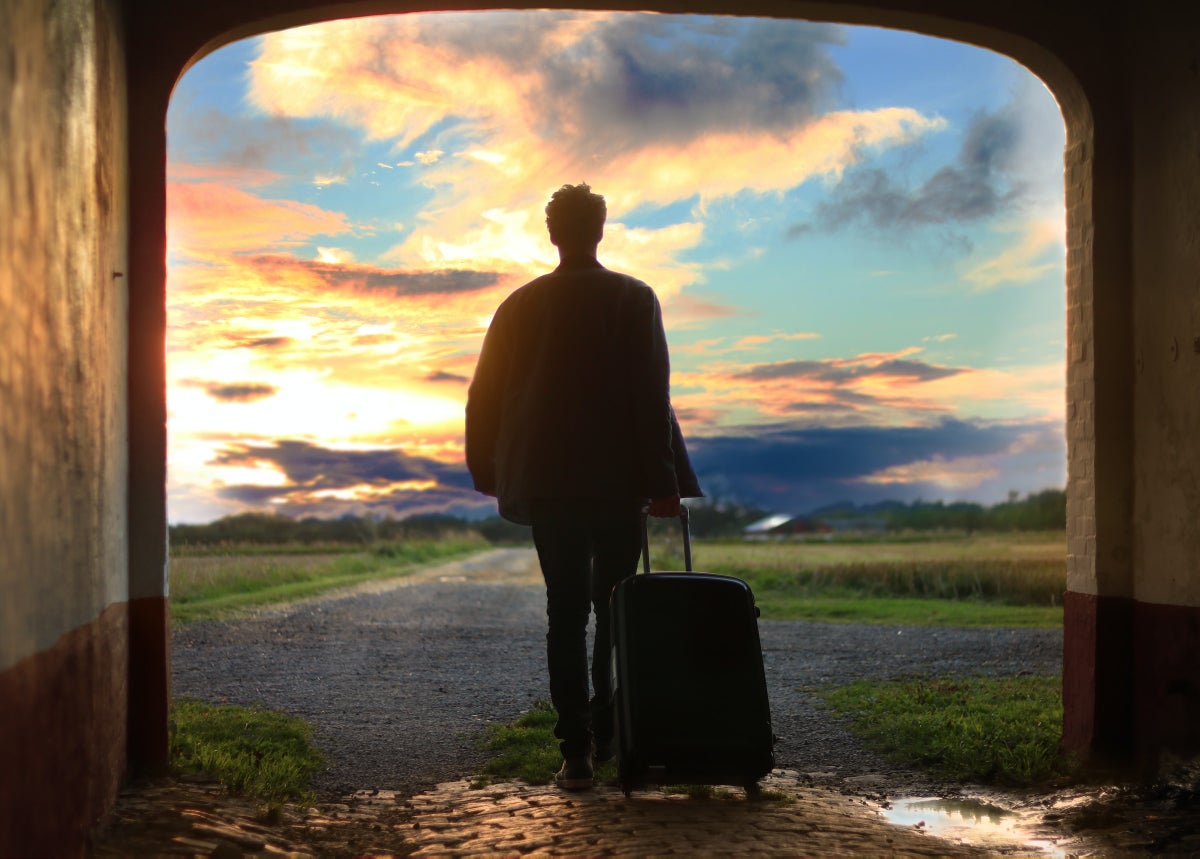
What Is Bleisure Travel?
Bleisure travel is everywhere, it’s a better use of time, make sure you get the leisure time you need (and deserve), have new and memorable travel experiences, feel more fulfilled and become a better employee, bleisure travel benefits both employees and companies, bleisure vs. workcation, how bleisure travelers can maximize hotel stays, credit cards, elite status, and rewards are key, the future of bleisure travel rewards, hyatt hotels, crowne plaza hotels, arlo hotels, how bleisure travelers can maximize home rentals, how rental property hosts can cater to bleisure travelers, what to pack for a bleisure trip, final thoughts.
We may be compensated when you click on product links, such as credit cards, from one or more of our advertising partners. Terms apply to the offers below. See our Advertising Policy for more about our partners, how we make money, and our rating methodology. Opinions and recommendations are ours alone.
As corporate and leisure travel have both bounced back after the COVID-19 pandemic, companies, travelers, and the travel industry itself are all figuring out how to navigate the “new normal” in the travel world, which includes concepts like revenge travel, the return of meetings and large events, a major focus on sustainable travel, and a particular concept we’ll focus on with this article: “bleisure travel.”
Business travel was slower to pick back up than leisure travel, but it’s made a comeback in recent months. Now, however, people have a decidedly new outlook on how to handle it, especially now that remote work and hybrid office models have stuck around beyond the end of the pandemic. Corporate travel and personal travel have evolved , and people are looking at these 2 spheres of travel in different ways and combining them like never done in the past.
We’ll discuss the bleisure travel trend, how people are doing it, how it can benefit you, and how the travel industry is (and should be) responding to it . We’ve interviewed professionals in the travel and event planning industry as well as business and bleisure travelers to understand a bit more about why and how this movement is changing the way people travel, work, and vacation.
Bleisure travel is the blending of both business and leisure travel , and it can be manifested in many different ways. Bleisure travel can mean:
- Business travelers who tack on extra personal days before or after a work trip, meeting, or corporate event
- Remote workers who take vacations but can also work remotely from whatever destination they’re in
- Business travelers who bring along friends or family with them to enjoy the hotel or destination while the main traveler is working or in meetings, then take time off to spend with them in the destination
- Any type of trip that combines traveling both for pleasure and professional purposes
We do want to make it clear that bleisure travel isn’t suggesting you take a personal vacation and turn it into a business trip. In fact, it’s really the opposite — ensuring you can make time for leisure and relaxation before, during, or after a work trip or corporate event.
Bleisure Travel Is Trending
People are more open to bleisure travel than ever before . According to a survey by Booking.com , business travel is picking back up. But in a post-COVID-19 world, employees want team building away from the office, which reflects a feeling that work travel includes “productive play.” In fact, 51% of survey participants are hoping to see their employer use the money saved from the shift to remote work spent on corporate travel and retreats.
And those whose companies have done so seem to have nothing but positive feedback. We chatted with a Paris-based product director in a tech startup who told us his 20-person company has employees around the world in places such as Sweden, France, and the U.S. While he’s able to voluntarily pop into the Paris office a few times a week, he also works from home and connects with his team during the optional quarterly meetup retreats his company offers.
“The trips are fully paid for by the company (travel, hotel, and food), usually a week long in destinations like the Alps, Mallorca, or Marrakech. It’s really helpful to spend time with the team, work in the morning, and do fun activities like yoga or skiing afterward. It’s also such a privilege to bring my family along — my company has even paid for a nanny to help with our 2 children. We work hard all quarter knowing these retreats are coveted rewards that also help with team building and connection,” he explained.
This move to mix business and leisure travel is happening in all industries and for all kinds of work trips. We spoke to Catherine Chaulet, President and CEO of Global DMC Partners , to understand more about why and how this is happening.
“ The trend to mix work and leisure is requested more and more for groups, meetings, and incentives. Allowing for free time is also now becoming a must. As meeting planners work on attracting attendees to their meetings, incentives, conferences, etc., they’ve had to integrate these into their programs. Attendees want free time to work but also to relax,” she told Upgraded Points.
As combining work and play becomes the norm, travelers, employers, and meeting planners are figuring out ways to incorporate leisure into work travel and events, including adventure, wellness , relaxation, family and friend time, exploring, and beyond.
Not convinced bleisure is for you, or aren’t sure how to incorporate it into your professional life and travels? Read on to find out how.
Bleisure Travel Offers Numerous Benefits
A study done by the Expedia Group in 2023 showed that 62% of travelers plan to travel in the next few months to relax and disconnect. And this is exactly why you should take a business trip and spin it into a bleisure trip. Why not take a few extra days and turn a work trip into some time to also relax, disconnect, and rejuvenate?
Here are just some of the ways bleisure travel can be beneficial to you.
If your company pays for airfare or you get a discount on additional hotel nights (or you can write the trip off as a business expense), you’re saving money on your vacation . And now, with the cost of airfare and accommodations on the rise, being able to travel affordably is key .
To understand a bit more about how employees can save money on bleisure travel, we spoke to Nick Morse, a Group Category Director at Rubix Group, who frequently travels for work and meetings.
He told us that since the pandemic ended, business travel has picked up once again, and he’s been traveling during weekdays and then using weekends to stay in destinations like London, Germany, and France. “It’s been a great way to get some fresh air and take a break, and at a reduced cost because my air travel is already paid for. When possible, I take my wife along, too, and she has time to relax and enjoy while I’m working; then we take the weekend exploring together, saving us money on a vacation.”
To understand the other side of things, we spoke to Michael Johnson, Senior Events Ninja at Event Dojo , who primarily plans incentives. He told us that he’s started to plan entire leisure days into incentive trips, and has had a 100% positive response from attendees. “People get to enjoy themselves without having to spend their own hard-earned money to do so. Additionally, with the costs of flights soaring, this huge expense is covered by their company, which allows them to extend their stay by a few nights on their own to really make a memorable vacation out of it.”
If you’re already on that 8-hour flight for a business trip, take advantage of this time . You’ve already spent the time flying and overcoming the jet lag. Now you can enjoy a getaway without having to fly long-haul again or catch up on missed sleep.
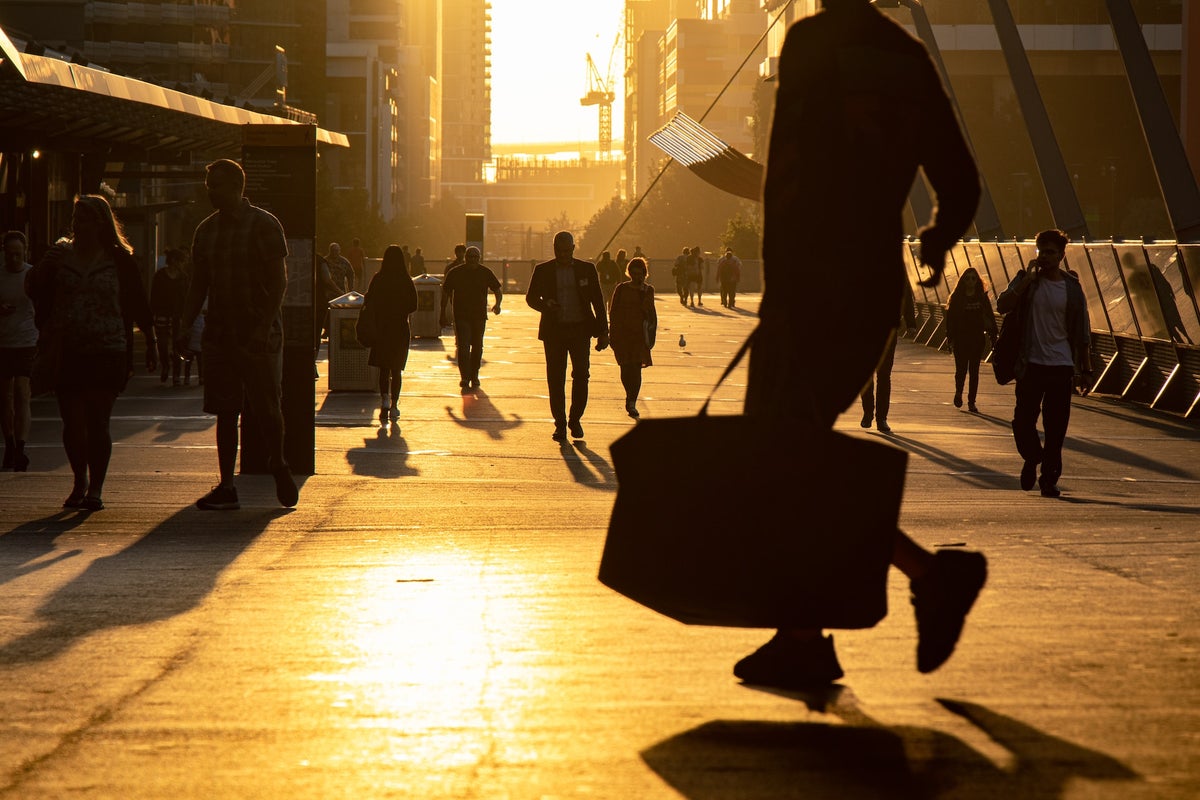
For example, we talked to an IT Project Manager for a global consulting firm who explained he loves flying to destinations that have a 1 to 2 hour time difference, but earlier. “I can get a head start on the East Coast with work, complete all my tasks by about 4 p.m. local time, and then enjoy the beach, restaurants, and nightlife like a local.”
According to a study by Pew Research Group , 51% of Americans don’t take all their vacation time. Tacking a leisure trip onto a business trip ensures you’ll take the vacation time you’re entitled to, especially if you don’t have the time and energy to plan a standalone vacation. You earned this time off — take it!
If you have a business trip or event in a foreign, far-flung destination, you may be exposed to a part of the world or a culture that you may never have gotten to see otherwise. You may even get to visit a state you hadn’t previously considered planning a vacation in. The IT Project Manager told us that his company has a small presence in Brazil, with 3 employees there that directly report to him.
By combining a trip to see the team with a vacation, he could both connect with his team and explore São Paulo. “I used less vacation time by combining a work trip with a vacation, and I was exposed to a whole new culture, which was exciting and novel,” he said.
And people within the travel industry are seeing this type of travel more and more, especially when it comes to meetings and events. Mr. Johnson mentioned that “ After unprecedented lockdowns, we’ve seen more excitement in getting out and exploring the world than in the years previous .”
The next time your company considers that meeting in Buenos Aires, an event in Bangkok, a corporate retreat to Egypt, or even a sales meeting in Wyoming, make sure to take advantage by tacking on a few extra days, turning a business trip into a bleisure experience to see a new place.
Rested employees are happy ones, and according to that aforementioned Booking.com study , more than half (59%) of workers around the world believe traveling can help them to be more productive at work, which brings us to our next point: Bleisure travel is good for businesses , too.
With a focus on remote and hybrid work, it’s more important than ever to get employees together — not just in business settings, but in leisure ones, too.
According to Ms. Chaulet, “Corporations sometimes have challenges building team spirit within their companies with staff working from home. Combining business and leisure on these trips helps build this sense of camaraderie among employees. This brings efficiency, better teamwork, and ultimately stronger loyalty to corporations .”
Extending a work trip to include some leisure time, or better yet, having leisure time built into a corporate retreat, event, or incentive trip, can boost employee efficiency, productivity, and fulfillment, leading to happier, healthier, and more loyal employees. This can boost team morale and company productivity , achieving a strong ROI and benefitting the bottom line in the process.
“ Workcations” and “bizcations” are terms that are often used interchangeably with bleisure travel, but it’s important to note that they aren’t the same thing .
Working during what’s supposed to be a relaxing vacation often happens (a workcation). Many Americans don’t take their allotted time off as it is, so if working on a vacation can be avoided, we suggest trying your best to make that happen (we know it’s not always possible). And workcations are also different than working remotely from a new destination — or digital nomad-ing — where you may travel to a place to work “from home” for a significant amount of time, but also build in some leisure or vacation time.
According to a JobSage survey , “More than half (59%) of Americans don’t like the concept of workcations.” And honestly, neither do we. Working during your vacation kinda stinks, after all. But the reality is that many people take workcations because they simply can’t take vacations. Some can’t fully disconnect, while others can’t dedicate the time to really relax and not work. According to the survey, 47% of respondents have taken a workcation because they felt they couldn’t take time off.
Instead of thinking of workcations and bleisure travel as the same thing, perhaps it’s time to think about bleisure travel as a possible solution (or at least a Band-Aid) to banishing workcations .
We can’t expect centuries of ingrained ideas about hard work to dissipate overnight, but perhaps tacking on a few days of “true vacation” after working hard during a corporate trip is a realistic scenario.
How Hotels Can (And Already Are) Catering to Bleisure Travelers
Employers aren’t the only ones capitalizing on bleisure to benefit their companies. Hotels are also taking note of this movement and offering amenities and features that benefit bleisure travelers.
IHG, for example, has called it “blended travel,” understanding that flexibility is key when it comes to providing comfortable stays for all kinds of travelers. Ginger Taggart, Vice President, Brand Management, Global Crowne Plaza, said in a white paper discussing the future of travel : “Our guests are looking for more flexibility to rebalance their lives, and we’re continuing to evolve and invest in the blended travel space to provide the lives that they now want to live as they travel.”
The paper states that 60% of U.S. travelers plan to add leisure days to future business travel, so hotels need to be ready, offering elements that bleisure travelers want.
A study by Passport Photo Online showed that 65% of Americans book hotel rooms for work 1 to 4 times a month, and nearly 72% of working professionals plan to use hotels for work in 2023 and beyond, noting that they have higher levels of productivity and creativity when working at a hotel.
According to travelers, things like having their bed made every day ( hotels that are cutting housekeeping — take note!) are really important for creating a comfortable working environment, as are things like plentiful food and drink offerings, speedy Wi-Fi, special discounted rates for those who extend business travel into leisure travel, comfortable in-room workspaces, business-friendly amenities like free adapters upon request or plenty of electrical outlets in guestrooms, a business center or dedicated co-working space, printing options, childcare options, and flexible check-in and checkout times.
The aforementioned study also stated good lighting and quiet rooms as additional wants and needs for bleisure travelers.
Beyond just amenities for business travelers, hotels need to embrace the versatility that a bleisure traveler needs to enjoy themselves during the leisure part of their trip, too, by offering things like pools, fitness centers, beach access, and beyond, all things someone might want to enjoy after a few days of meetings or work events.
Bleisure travelers need the best of both worlds: amenities that benefit business travelers as well as amenities that make for a fun and comfortable leisure vacation. Find a hotel that has it all for the best bleisure travel possible.
Holding certain travel credit cards , membership, or elite status can make it easier for travelers to get some of these perks. For example, the Marriott Bonvoy Business ® American Express ® Card offers a 7% discount on standard rates for reservations of standard guest rooms at participating Marriott Bonvoy hotels when booked direct (terms apply), as well as complimentary Gold Elite status , which offers late 2 p.m. checkout (upon availability), among other benefits. The Amex Fine Hotels + Resorts program offers early check-in when available and late checkout at 4 p.m.
Looking to capitalize on hotel benefits like late checkout? A host of c redit cards offer hotel complimentary elite status so you can take advantage of perks like free Wi-Fi, late checkout, early check-in, and much more
These benefits can provide essential value for bleisure travelers. The IT manager we spoke to told us, “When I go to European destinations like Madrid, I stay in hotels with free and fast Wi-Fi and work U.S. ET hours. This frees up my morning on Central European Time for exploring the city, cafes, etc., and as Madrid has a later nightlife, I still have time for dinner after work. Without early check-in, this would be more difficult. And thanks to late checkouts due to hotel [elite] status, I can often put in 8 hours at a hotel on the day of departure and then fly home or onwards to another destination for some additional time off. That certainly helps, too.”
Mr. Johnson looks at these types of perks from the eyes of an event planner, floating the possibility that hotels could further reward business travelers that tack on additional leisure days after meetings and events. “I’d love to see hotel properties get creative with how they reward and incentivize business and bleisure travel , especially for meetings and incentives attendees,” he said.
And we’re hoping to see the same. We think that beyond just a variety of amenities, hotel loyalty programs should incentivize business travelers with discounts, additional points, and perks, encouraging them to become bleisure travelers, which is a win-win for everyone.
Bleisure Travelers Should Stay at These Hotels

Obviously, you can’t always pick where your company is hosting a business trip, meeting, or corporate retreat. But if you have any say in the matter or are able to work remotely, consider these hotel brands, which offer amenities and perks to bleisure travelers, digital nomads, and remote workers . Likewise, meeting planners and corporations should take note of which hotels are catering their offerings toward bleisure travelers.
Hyatt’s Work from Hyatt program offers hotel rooms for daily work use, but bleisure travelers should perhaps consider its Great Relocate program, ideal for digital nomads and remote workers who want to combine working with a vacation for a period longer than 29 days. Find this program in 125+ hotels throughout Africa, Europe, India, and the Middle East, including popular destinations like Paris and Dubai. It offers perks like discounts on laundry services and complimentary boardroom access.
Loyal to Hyatt? Get The World of Hyatt Credit Card to earn bonus points on Hyatt hotel stays.
Crowne Plaza’s Plaza Workspaces are hybrid spaces designed to adapt to whatever a bleisure travel needs, from co-working and collaboration spaces to large meeting rooms. Find them at Crowne Plaza locations in cities including Atlanta and Los Angeles.
This trendy boutique chain has business offerings like cool co-working spaces and rooftop bars for when you’re ready for an after-work drink or weekend hangout spot. Booking an Arlo Means Business stay means you’ll get 40% off the best available rate , waived urban fees, and late checkout when available. Arlo properties are located in Chicago, Miami, and New York.
How Home Rentals Can (And Already Are) Catering to Bleisure Travelers
Home rentals are also an easy way to combine meetings, remote work, or corporate travel of any kind with a leisure trip . They’re especially ideal for longer trips or for anyone who wants to work remotely but also take time off for a vacation, too.
Websites like Airbnb have filter options like “dedicated workspace,” and you can also filter for any leisure amenities you’d like to have from pools to BBQ grills and more.
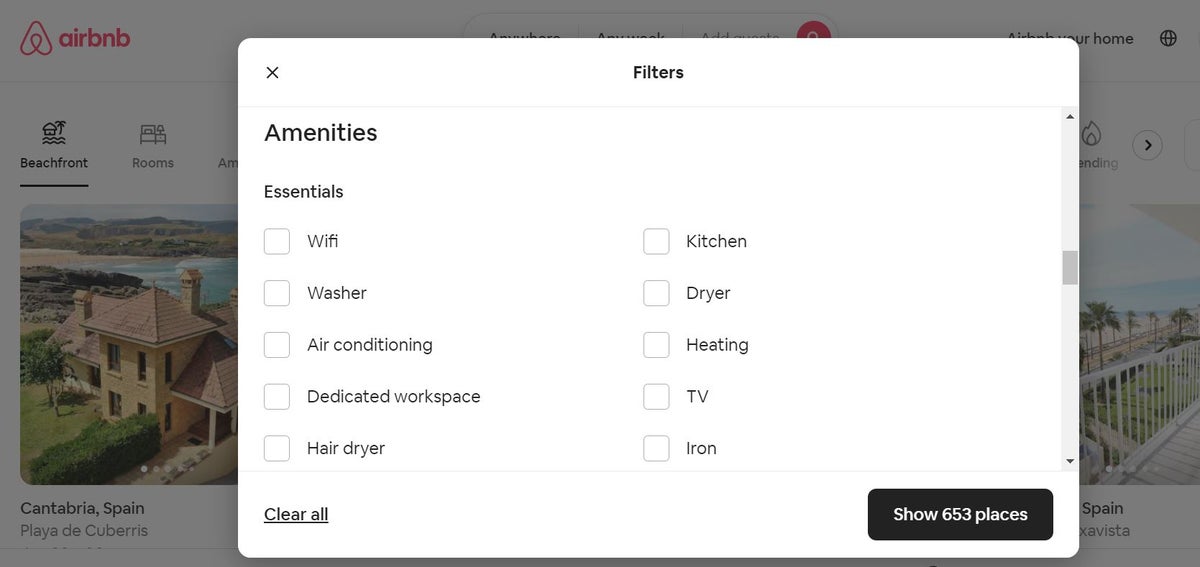
Some vacation rentals also offer long-term discounts for week or month-long stays that can make them more affordable for bleisure travelers. Some may even have multiple work areas, relaxing outdoor spaces, or office supplies, or are kid- and pet-friendly so you can take the whole family along. VRBO allows users to filter properties by “family-friendly,” ideal for bleisure travelers who want amenities for the kids like high chairs, cribs, play areas, etc.
It’s always a good idea to read reviews and see what people say about working remotely at a given property. Message the host to check the Wi-Fi speeds, too!
One senior marketing executive at a New York City-based media agency told us he loved a recent bleisure trip to Mexico, thanks to an incredible rental he was able to find. He was there for almost 4 months, working during the week and taking long weekends to relax, unwind, and discover more about the local culture. “The most important amenities to me were speedy Wi-Fi and organizing with the host to have a weekly cleaner, with whom I was able to chat and practice my Spanish. It felt like home and was the perfect place to decompress and have a vacation after long work days,” he said.
If you’re a host, make sure to update your listing and explain why it’s a great fit for business or bleisure travelers, take photos that accurately reflect workspaces (extra points for Zoom-friendly backgrounds) and leisure amenities, and offer discounts for longer stays . You can even include words like “leisure,” “business,” “digital nomad,” or “remote work” in the description. Extra amenities, such as complimentary office supplies or well-stocked kitchens, can go a long way, too.
Every bleisure trip is different, of course, but it’s best to pack day-to-night pieces that can work for both a meeting and a leisure activity, like dinner or a stroll around town. Obviously, weather and destination are both big factors when it comes to packing, but packing layers is a good idea, as well as pieces that can pull double duty. A mix-and-match capsule wardrobe that works for a variety of occasions and situations is key.
When in doubt, make sure you concentrate on business wear because it’s a lot easier to pick up a swimsuit coverup or sunglasses at the hotel gift shop or in town than it is to find a perfectly tailored suit. Don’t forget any gear you’ll need for work, like a mouse, chargers, microphone, headphones, etc., and throw in your favorite vacation items, too, like that beloved baseball cap and a good poolside read.

Bleisure travel is trending, and we don’t see it going anywhere anytime soon . As Ms. Chaulet put it, “Bleisure is much more convenient today,” and we couldn’t agree more. Take advantage of that company-funded plane ticket and add on a few vacation days after a business trip. You’ll likely return home a healthier and happier employee.
The information regarding The World of Hyatt Credit Card was independently collected by Upgraded Points and not provided nor reviewed by the issuer.
For rates and fees of the Marriott Bonvoy Business ® American Express ® Card, click here .
Frequently Asked Questions
What are the benefits of bleisure.
Bleisure travel has numerous benefits. To start, it can benefit the traveler, because they can save money and time while having leisure and vacation time during a work or corporate trip. It also helps companies, as employees are happier and better rested after a bleisure trip. Finally, hotels can benefit from customers staying longer by adding additional days to a corporate trip, event, or meeting.
What is the concept of bleisure?
Bleisure is the combination of business and leisure travel. It refers to anyone that takes a work trip but also enjoys a vacation, too. Post-pandemic, bleisure travel has become very popular, as flexible work schedules make the concept easier to manifest.
What is the difference between workcation and bleisure?
A workcation isn’t as great as it sounds. It happens when you take a vacation but end up doing work. In contrast, a bleisure trip is taking a work trip and adding an element of vacation to it.
What does bleisure mean in tourism?
Bleisure is the combination of 2 types of travel: business and leisure. Bleisure travelers usually work or are in meetings during the day, but enjoy tourism during the vacation element of their trip.
Was this page helpful?
About Lori Zaino
Lori is an intrepid traveler who loves creating itineraries that exude “luxe on a budget.” She’s written for CNN, NBC, The Infatuation, and more, and loves to muse about points-fueled trips to Sri Lanka, Sicily, and Myanmar.
INSIDERS ONLY: UP PULSE ™

Get the latest travel tips, crucial news, flight & hotel deal alerts...
Plus — expert strategies to maximize your points & miles by joining our (free) newsletter.
We respect your privacy . This site is protected by reCAPTCHA. Google's privacy policy and terms of service apply.
Related Posts

UP's Bonus Valuation
This bonus value is an estimated valuation calculated by UP after analyzing redemption options, transfer partners, award availability and how much UP would pay to buy these points.

The 17 different types of travel
Disclaimer: Some posts on Tourism Teacher may contain affiliate links. If you appreciate this content, you can show your support by making a purchase through these links or by buying me a coffee . Thank you for your support!
Travel and tourism is a diverse industry and there are many different types of travel. The type of travel will determine the methods of business, the types of customer that it attracts and the the destination type that is facilitating tourism. In this article I will tell you all about the main types of travel and give you some examples of each.
The different types of travel
Short breaks, city breaks, countryside breaks, stag and hen parties, special events, mice tourism, short-term work contracts, types of specialist travel, vfr: migrants and expats, types of day trips, to conclude: types of travel, further reading.
Separating the different types of travel into clear segments or categories isn’t always an easy task.
Some types of travel may span more than one category- for example a person can go on a short break that is also corporate travel.
And others may be somewhat subjective- what is a short break? Is it two days? Is it four days? This is not clear-cut.
However, whilst accurately segregating types of travel into distinct categories may not be an easy task, it can be useful to have general classifications.
Categorising holidays into different types of travel helps us to better understand and assess the market segment in question. It also enables better tourism management and planning .
So what are the different types of travel? If video is your thing, watch the short video below, which covers all of the different types of travel, if not, read on…
Leisure travel
Leisure travel generally refers to travel that is undertaken for the purpose of pleasure, enjoyment, relaxation or special interests.
Leisure travel is an important component of tourism , and makes up a significant part of the tourism industry .
There are different ways that someone can undertake leisure travel. I have outlined these below.
Short breaks have become increasingly popular since the advent of the low cost airline .
Cheaper fares and regular flights have meant that people have been able to jet off for a weekend break that may not have previously been possible. In fact, [pre COVID] trends have shown that many people are now choosing to take 2-3 short breaks each year rather than a singular, more traditional summer holiday.
Short breaks are especially popular in areas that are well-connected. In Europe, for instance, it is easy to go on a short break from London to Paris. However, if you lived in Australia , the vast distances between destinations may mean that short breaks are less feasible.
City breaks are a popular type of travel.
Cities have lots to offer such as entertainment options (eating out, shows, events etc), as well as a range of tourist attractions and business tourism opportunities.
Cities are usually well connected by transport, making them easily reachable for tourists.
Rural tourism is very popular since the COVID pandemic. Countryside breaks enable people to enjoy the fresh air and to be socially distant from others.
There are many things to do on a countryside break, from hiking the Mendips , to adventure sports such as rock climbing in places like Cheddar Gorge .
It is a tradition for brides and grroms-to-be to celebrate their forthcoming marriage with a stag party or hen party. Whilst this might last for just a few hours, many people are now choosing to travel to a place outside of their home for a short break.
There are many destinations that are popular for stag or hen parties. These are usually destinations which have a substantial nightlife scene.
In Europe, many people go on a stag or hen party to Riga , Barcelona, Manchester, London, Lisbon, Benidorm, Krakow, Liverpool, Amsterdam… to name but a few.
There are different types of holidays that constitute leisure tourism.
Throughout the history of tourism , package holidays have been a popular type of travel. Packages are put together by tour operators and are then sold by different types of travel agent . This makes travel easier for the consumer.
Many people also choose to undertake independent travel. Whether tourists choose to create a dynamic package or travel on the fly, this is a popular method of leisure travel.
Cruise tourism has also grown considerably in recent years. Cruise ships come in all shapes and sizes and are popular with a wide variety of tourist types. Cruising is a form of enclave tourism .
Many people who travel for leisure are doing so to spectate or be involved in a major sporting event .
There are a large number of events that make up an important part of the sports tourism industry. Some examples include the annual Wimbledon Tennis tournament, the Formula 1 Grand Prix and the Football World Cup.
There are also other major events that people may choose to travel for. This could be, for example, the Chelsea Flower Show in London, the Day of the Dead festival in Mexico , Songkran in Thailand or the Glastonbury music festival.

Corporate travel
One of the most important (but often forgotten about!) types of travel is corporate travel.
Corporate travel, also referred to as business tourism , is any travel that is associated with or related to a person’s job or work.
Corporate travel may or may not involve staying away from home overnight.
Some types of corporate travel that you may encounter include:
MICE stands for- meetings, incentives, conferences, exhibitions. These are four important areas of the corporate travel market.
Many people will travel to attend meetings. Although, with the growth of the shut-in economy and software programmes such as Zoom and Microsoft Teams, travel for meetings has decreased significantly.
Incentive travel is travel which is given as a reward for good performance at work. It is designed to act as a motivator for staff; encouraging them to worker harder, ac hive better results and ultimately make more money for the business.
Conferences and exhibitions are an important tool for sharing ideas and networking. Similarly to meetings, many of these have now been moved online. However, it is unlikely that the conference market will disappear completely, as networking via a computer screen will never yield the same benefits as having a face-to-face conversation.
Training courses are, and will continue to be, essential to successful tourism operations management. Staff need to be trained for the position that they will/are working in and will need to be regularly unskilled.
Staff may also wish to undertake extra training for promotions or to keep up to date with industry developments.
Training courses can be in your place of work, but they can take place in alternative destinations; meaning that they facilitate a form of corporate travel.
Corporate travel can also consist of temporary work contracts. This is when a person is required to work in a location outside of their home environment for a specified period of time.
Whilst the time-frame is not clearly defined, if somebody relocates for work, they are then classified as an expatriate rather than a business tourist.
Work contracts such as these can be based within the employee’s home country or they can be based overseas.
Specialist travel
Specialist travel, often referred to as special interest tourism, is a form of niche tourism. It groups together an indefinite number of types of tourism that are specialist in nature.
Specialist tourism is often linked to a personal hobby, sport or interest. It may also be a type of travel that meets a specific need of a particular tourist or group of tourists.
I have outlined over 150 different types of specialist tourism in my types of tourism glossary – I told you, there are A LOT of different tourism types!
Some of the most common types of tourism include adventure tourism, health tourism, educational tourism, heritage and cultural tourism , gap year travel, conservation, sustainable tourism , responsible tourism and honeymoon tourism.
Visiting Friends and Relatives (VFR)
Visiting friends and relatives (VFR) is one of the biggest market segments in travel and tourism and is one of the most important types of travel.
People travel all around the world to visit their friends and relatives. This is an important form of domestic tourism as well as inbound tourism and outbound tourism .
Sometimes VFR will involve an overnight stay, and other times it will not. Travellers may choose to stay with their friends or relatives in their home or they may book accommodation of their own.
VFR is an especially prominent type of travel in areas with high migration or expatriation. For example, there are thousands of tourists who travel from the UK to India and Poland each year to visit family and friends, This is because there are a high number of Indian and Polish migrants in the UK.
Another important type of travel is day trips. Whilst according to some definitions of tourism, one may not technically be classified as a tourist unless they stay away from home overnight, they are nonetheless a valuable contribution to the tourism economy.
Most people who undertake a day trip will be visiting friends and relatives or in search of leisure or business.
Many people will choose to take a day trip to visit a tourist attraction, to go shopping, to attend an event, to visit the countryside or to take part in various activities.
A day trip can take part close to your home or it can form part of a holiday, i.e. you take a tour from your hotel whilst on holiday.
As you can see, there are many different types of travel, which can broadly be categorised as: leisure travel, corporate travel, specialist travel, visiting friends and relatives and day trips. All of these types of travel provide important contributions to the wider tourism industry and segmentation in this way allows us to assess and organise the industry according to the types of travel that are under scrutiny.
- The 3 Major Types Of Airlines + How They Work
- 50 types of transport from around the world
- 21 Types of Tourists Around The World
- 20 Popular Types of Hotels Around The World
- 150 types of tourism! The ultimate tourism glossary
Liked this article? Click to share!

Want to create or adapt books like this? Learn more about how Pressbooks supports open publishing practices.
Chapter 1. History and Overview
1.1 What is Tourism?
Before engaging in a study of tourism , let’s have a closer look at what this term means.
Definition of Tourism
There are a number of ways tourism can be defined, and for this reason, the United Nations World Tourism Organization (UNWTO) embarked on a project from 2005 to 2007 to create a common glossary of terms for tourism. It defines tourism as follows:
Tourism is a social, cultural and economic phenomenon which entails the movement of people to countries or places outside their usual environment for personal or business/professional purposes. These people are called visitors (which may be either tourists or excursionists; residents or non-residents) and tourism has to do with their activities, some of which imply tourism expenditure (United Nations World Tourism Organization, 2008).
Using this definition, we can see that tourism is not just the movement of people for a number of purposes (whether business or pleasure), but the overall agglomeration of activities, services, and involved sectors that make up the unique tourist experience.
Tourism, Travel, and Hospitality: What are the Differences?
It is common to confuse the terms tourism , travel , and hospitality or to define them as the same thing. While tourism is the all-encompassing umbrella term for the activities and industry that create the tourist experience, the UNWTO (2020) defines travel as the activity of moving between different locations often for any purpose but more so for leisure and recreation (Hall & Page, 2006). On the other hand, hospitality can be defined as “the business of helping people to feel welcome and relaxed and to enjoy themselves” (Discover Hospitality, 2015, p. 3). Simply put, the hospitality industry is the combination of the accommodation and food and beverage groupings, collectively making up the largest segment of the industry (Go2HR, 2020). You’ll learn more about accommodations and F & B in Chapter 3 and Chapter 4 , respectively.
Definition of Tourist and Excursionist
Building on the definition of tourism, a commonly accepted description of a tourist is “someone who travels at least 80 km from his or her home for at least 24 hours, for business or leisure or other reasons” [1] . The United Nations World Tourism Organization (1995) helps us break down this definition further by stating tourists can be:
- Domestic (residents of a given country travelling only within that country)
- Inbound (non-residents travelling in a given country)
- Outbound (residents of one country travelling in another country)
Excursionists on the other hand are considered same-day visitors (UNWTO, 2020). Sometimes referred to as “day trippers.” Understandably, not every visitor stays in a destination overnight. It is common for travellers to spend a few hours or less to do sightseeing, visit attractions, dine at a local restaurant, then leave at the end of the day.
The scope of tourism, therefore, is broad and encompasses a number of activities and sectors.
Spotlight On: United Nations World Tourism Organization (UNWTO)
UNWTO is the United Nations agency responsible “for the promotion of responsible, sustainable and universally accessible tourism” (UNWTO, 2014b). Its membership includes 159 countries and over 500 affiliates such as private companies, research and educational institutions, and non-governmental organizations. It promotes tourism as a way of developing communities while encouraging ethical behaviour to mitigate negative impacts. For more information, visit the UNWTO website .
The North American Industry Classification System (NAICS). Given the sheer size of the tourism industry, it can be helpful to break it down into broad industry groups using a common classification system. The North American Industry Classification System (NAICS) was jointly created by the Canadian, US, and Mexican governments to ensure common analysis across all three countries (British Columbia Ministry of Jobs, Tourism and Skills Training, 2013a). The tourism-related groupings created using NAICS are (in alphabetical order):
- Accommodation
- Food and beverage services (commonly known as “F & B”)
- Recreation and entertainment
- Transportation
- Travel services
These industry groups (also commonly known as sectors) are based on the similarity of the “labour processes and inputs” used for each (Government of Canada, 2013). For instance, the types of employees and resources required to run an accommodation business whether it be a hotel, motel, or even a campground are quite similar. All these businesses need staff to check in guests, provide housekeeping, employ maintenance workers, and provide a place for people to sleep. As such, they can be grouped together under the heading of accommodation. The same is true of the other four groupings, and the rest of this text explores these industry groups, and other aspects of tourism, in more detail.

It is typical for the entire tourist experience to involve more than one sector. The combination of sectors that supply and distribute the needed tourism products, services, and activities within the tourism system is called the Tourism Supply Chain. Often, these chains of sectors and activities are dependent upon each other’s delivery of products and services. Let’s look at a simple example below that describes the involved and sometimes overlapping sectoral chains in the tourism experience:
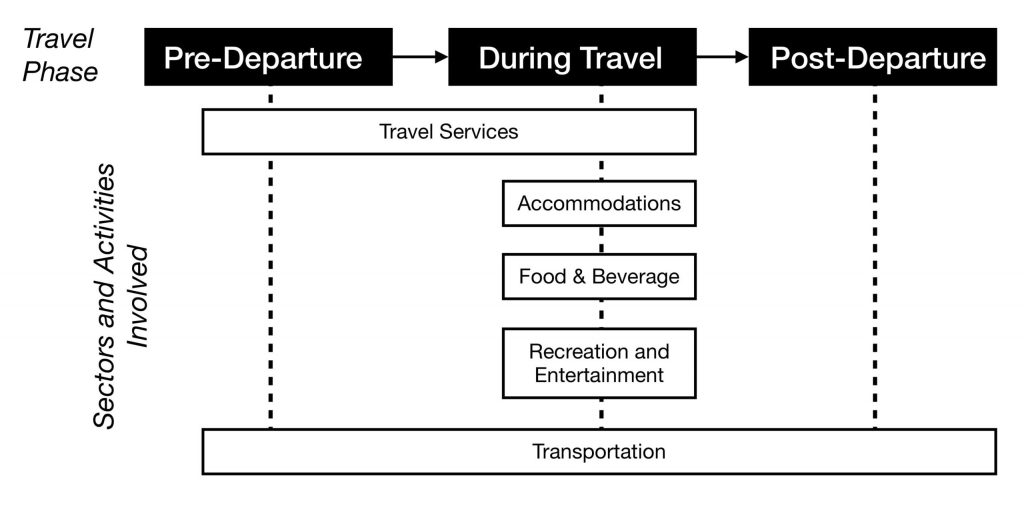
Before we seek to understand the five tourism sectors in more detail, it’s important to have an overview of the history and impacts of tourism to date.
Media Attributions
Front Desk © Staying LEVEL is licensed under a CC BY-NC (Attribution NonCommercial) license
- (LinkBC, 2008, p.8) ↵
Tourism according the the UNWTO is a social, cultural and economic phenomenon which entails the movement of people to countries or places outside their usual environment for personal or business/professional purposes.
UN agency responsible for promoting responsible, sustainable, and universally accessible tourism worldwide.
Moving between different locations for leisure and recreation.
The accommodations and food and beverage industry groupings.
someone who travels at least 80 km from his or her home for at least 24 hours, for business or leisure or other reasons
A same-day visitor to a destination. Their trip typically ends on the same day when they leave the destination.
A way to group tourism activities based on similarities in business practices, primarily used for statistical analysis.
Introduction to Tourism Copyright © 2020 by NSCC is licensed under a Creative Commons Attribution 4.0 International License , except where otherwise noted.
Share This Book
U.S. Leisure Travel Is Back at Pre-Pandemic Levels for the First Time
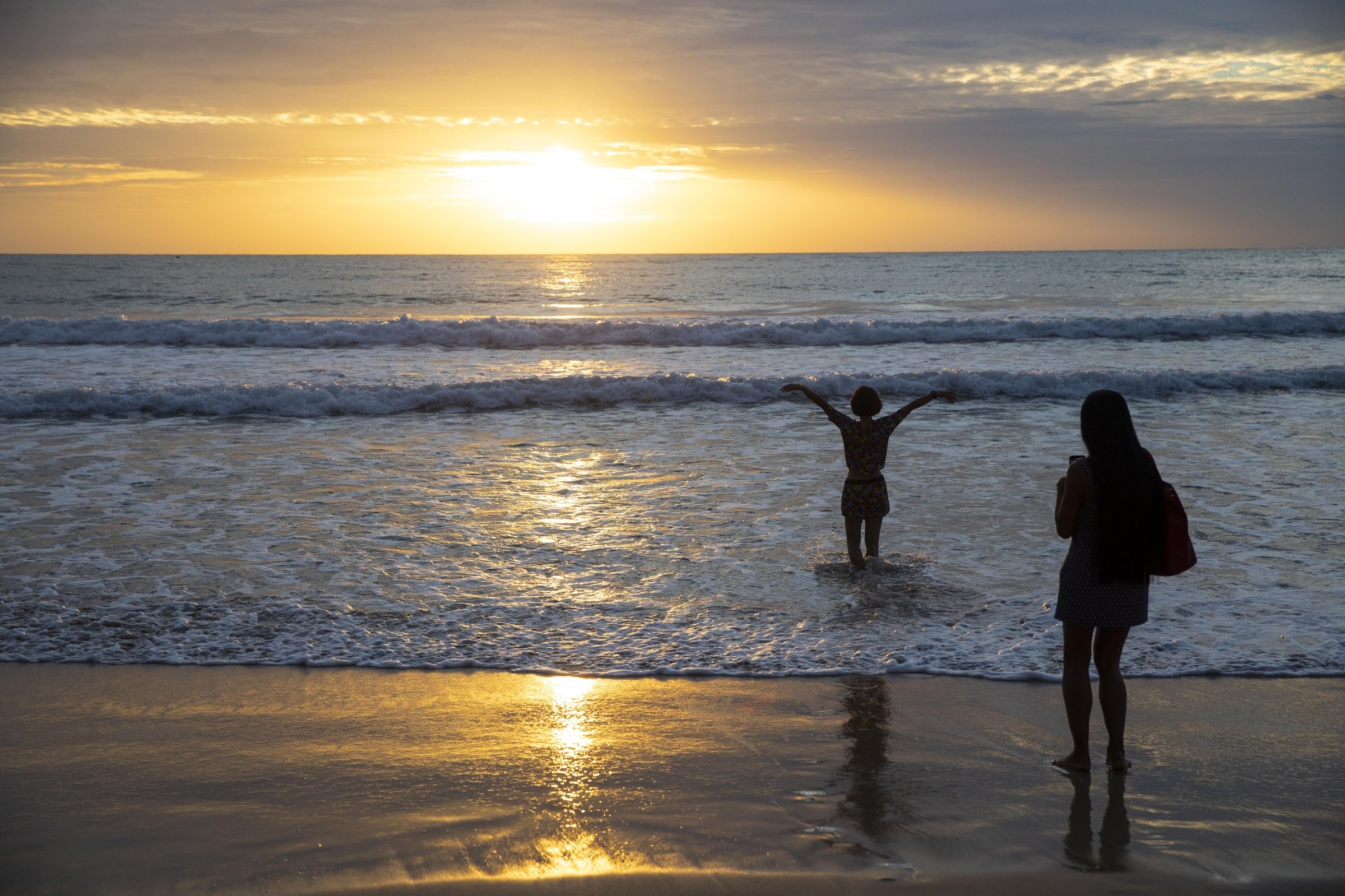
US consumers are spending less on products and more on experiences — a trend that could ease supply snags and inflationary pressures, and help the travel industry this summer.
For the first time since COVID halted movement around the world, leisure travel has returned to 2019 levels, according to a report released by the Mastercard Economics Institute. People are feeling more comfortable heading off to far flung adventures, despite a surge in cases and average airfares jumping 18% globally since the start of the year.
“If flight bookings continue at their current pace, an estimated 1.5 billion more passengers globally will fly in 2022 compared to last year,” the report said, “with Europe seeing the biggest increase — about 550 million.”
Read More: What to Do If You Test Positive for COVID-19 While Traveling
Short and medium-haul flights are up 25% and 27% in April over the same period in 2019. Long-haul trips, which started the year 75% below pre-pandemic levels, rebounded to just 7% below 2019 by the end of April. Passenger rail is similarly close, with buses back to where they were. Spending on cruises started the year 75% off the 2019 peak and are now just 10% shy of a full recovery.
Pent-up demand for experiences appears to be driving the wanderlust with tourist spending on nightclubs and bars up 72% above 2019 levels, restaurants up 31%, and other recreational activities like museum, concerts and amusement parks up 35%, according to the report. By comparison, tourist spending is down for retail goods like clothes and cosmetics.
The report found the most popular international destination in March for travelers leaving North America was Mexico, and departing Europe, Middle East and Africa, was the UK. The US tops the list for those traveling from Latin America, the Caribbean, and the Asia-Pacific regions.
More Must-Reads From TIME
- The 100 Most Influential People of 2024
- Coco Gauff Is Playing for Herself Now
- Scenes From Pro-Palestinian Encampments Across U.S. Universities
- 6 Compliments That Land Every Time
- If You're Dating Right Now , You're Brave: Column
- The AI That Could Heal a Divided Internet
- Fallout Is a Brilliant Model for the Future of Video Game Adaptations
- Want Weekly Recs on What to Watch, Read, and More? Sign Up for Worth Your Time
Contact us at [email protected]

Want to create or adapt books like this? Learn more about how Pressbooks supports open publishing practices.
Chapter 1. History and Overview
1.1 What is Tourism?
Before engaging in a study of tourism , let’s have a closer look at what this term means.
Definition of Tourism
There are a number of ways tourism can be defined, and for this reason, the United Nations World Tourism Organization (UNWTO) embarked on a project from 2005 to 2007 to create a common glossary of terms for tourism. It defines tourism as follows:
Tourism is a social, cultural and economic phenomenon which entails the movement of people to countries or places outside their usual environment for personal or business/professional purposes. These people are called visitors (which may be either tourists or excursionists; residents or non-residents) and tourism has to do with their activities, some of which imply tourism expenditure (United Nations World Tourism Organization, 2008).
Using this definition, we can see that tourism is not just the movement of people for a number of purposes (whether business or pleasure), but the overall agglomeration of activities, services, and involved sectors that make up the unique tourist experience.
Tourism, Travel, and Hospitality: What are the Differences?
It is common to confuse the terms tourism , travel , and hospitality or to define them as the same thing. While tourism is the all-encompassing umbrella term for the activities and industry that create the tourist experience, the UNWTO (2020) defines travel as the activity of moving between different locations often for any purpose but more so for leisure and recreation (Hall & Page, 2006). On the other hand, hospitality can be defined as “the business of helping people to feel welcome and relaxed and to enjoy themselves” (Discover Hospitality, 2015, p. 3). Simply put, the hospitality industry is the combination of the accommodation and food and beverage groupings, collectively making up the largest segment of the industry (Go2HR, 2020). You’ll learn more about accommodations and F & B in Chapter 3 and Chapter 4 , respectively.
Definition of Tourist and Excursionist
Building on the definition of tourism, a commonly accepted description of a tourist is “someone who travels at least 80 km from his or her home for at least 24 hours, for business or leisure or other reasons” (LinkBC, 2008, p.8). The United Nations World Tourism Organization (1995) helps us break down this definition further by stating tourists can be:
- Domestic (residents of a given country travelling only within that country)
- Inbound (non-residents travelling in a given country)
- Outbound (residents of one country travelling in another country)
Excursionists on the other hand are considered same-day visitors (UNWTO, 2020). Sometimes referred to as “day trippers.” Understandably, not every visitor stays in a destination overnight. It is common for travellers to spend a few hours or less to do sightseeing, visit attractions, dine at a local restaurant, then leave at the end of the day.
The scope of tourism, therefore, is broad and encompasses a number of activities and sectors.
Spotlight On: United Nations World Tourism Organization (UNWTO)
UNWTO is the United Nations agency responsible “for the promotion of responsible, sustainable and universally accessible tourism” (UNWTO, 2014b). Its membership includes 159 countries and over 500 affiliates such as private companies, research and educational institutions, and non-governmental organizations. It promotes tourism as a way of developing communities while encouraging ethical behaviour to mitigate negative impacts. For more information, visit the UNWTO website .
NAICS: The North American Industry Classification System
Given the sheer size of the tourism industry, it can be helpful to break it down into broad industry groups using a common classification system. The North American Industry Classification System (NAICS) was jointly created by the Canadian, US, and Mexican governments to ensure common analysis across all three countries (British Columbia Ministry of Jobs, Tourism and Skills Training, 2013a). The tourism-related groupings created using NAICS are (in alphabetical order):
- Accommodation
- Food and beverage services (commonly known as “F & B”)
- Recreation and entertainment
- Transportation
- Travel services
These industry groups (also commonly known as sectors) are based on the similarity of the “labour processes and inputs” used for each (Government of Canada, 2013). For instance, the types of employees and resources required to run an accommodation business whether it be a hotel, motel, or even a campground are quite similar. All these businesses need staff to check in guests, provide housekeeping, employ maintenance workers, and provide a place for people to sleep. As such, they can be grouped together under the heading of accommodation. The same is true of the other four groupings, and the rest of this text explores these industry groups, and other aspects of tourism, in more detail.

It is typical for the entire tourist experience to involve more than one sector. The combination of sectors that supply and distribute the needed tourism products, services, and activities within the tourism system is called the Tourism Supply Chain. Often, these chains of sectors and activities are dependent upon each other’s delivery of products and services. Let’s look at a simple example below that describes the involved and sometimes overlapping sectoral chains in the tourism experience:

Before we seek to understand the five tourism sectors in more detail, it’s important to have an overview of the history and impacts of tourism to date.

Long Descriptions
Figure 1.2 long description: Diagram showing the tourism supply chain. This includes the phases of travel and the sectors and activities involved during each phase.
There are three travel phases: pre-departure, during travel, and post-departure.
Pre-departure, tourists use the travel services and transportation sectors.
During travel, tourists use the travel services, accommodations, food and beverage, recreation and entertainment, and transportation sectors.
Post-departure, tourists use the transportation sector.
[Return to Figure 1.2]
Media Attributions
- Front Desk by Staying LEVEL is licensed under a CC BY-NC 4.0 Licence .
Tourism according the the UNWTO is a social, cultural and economic phenomenon which entails the movement of people to countries or places outside their usual environment for personal or business/professional purposes.
UN agency responsible for promoting responsible, sustainable, and universally accessible tourism worldwide.
Moving between different locations for leisure and recreation.
The accommodations and food and beverage industry groupings.
someone who travels at least 80 km from his or her home for at least 24 hours, for business or leisure or other reasons
A same-day visitor to a destination. Their trip typically ends on the same day when they leave the destination.
A way to group tourism activities based on similarities in business practices, primarily used for statistical analysis.
Introduction to Tourism and Hospitality in BC - 2nd Edition Copyright © 2015, 2020, 2021 by Morgan Westcott and Wendy Anderson, Eds is licensed under a Creative Commons Attribution 4.0 International License , except where otherwise noted.
Share This Book
Pleasure tourism
- Living reference work entry
- First Online: 01 January 2015
- Cite this living reference work entry

- Salvatore Bimonte 3
1994 Accesses
Pleasure is defined as a feeling of happiness, satisfaction, or enjoyment. Therefore, the pursuit of such feelings through travel is referred to as pleasure tourism. According to Currie ( 1997 ), “tourism” means pleasure travel, and according to the UNWTO ( 2007 ), pleasure represents the main purpose of tourism.
In the research literature, pleasure tourism is normally defined in opposition to business tourism. The classification is partly driven by statistical measurement conventions that mainly focus on the purpose of a trip rather than on its motivations. The UNWTO ( 2007 ) classifies tourism into two broad categories: personal and business/professional purposes. The former can be broken down into subcategories such as holidays, leisure, and recreation; visiting friends and relatives; education and training; health and medical care; religion and pilgrimages; shopping; and other pursuits.
The previous classifications do not distinguish between pleasure and non-pleasure tourism. In the...
This is a preview of subscription content, log in via an institution to check access.
Access this chapter
Institutional subscriptions
Bimonte, S., and V. Faralla 2012 Tourist Types and Happiness: A Comparative Study in Maremma, Italy. Annals of Tourism Research 39:1929-1950.
Article Google Scholar
Bimonte, S., and V. Faralla 2013 Happiness and Outdoor Vacations: Appreciative versus Consumptive Tourists. Journal of Travel Research, DOI: 10.1177/0047287513513171.
Google Scholar
Currie, R. 1997 A Pleasure Tourism Behaviors Framework. Annals of Tourism Research 24:884-897.
Smith, V. 1989 Host and Guest: The Anthropology of Tourism. Philadelphia: The University of Pennsylvania Press.
UNWTO 2007 International Recommendations on Tourism Statistics. Madrid: World Tourism Organization.
Download references
Author information
Authors and affiliations.
Department of Economics and Statistics, University of Siena, Via Banchi di Sotto, 55/4, 53100, Siena, Italy
Salvatore Bimonte
You can also search for this author in PubMed Google Scholar
Corresponding author
Correspondence to Salvatore Bimonte .
Editor information
Editors and affiliations.
School of Hospitality Leadership, University of Wisconsin-Stout, Menomonie, Wisconsin, USA
Jafar Jafari
School of Hotel and Tourism Management, The Hong Kong Polytechnic University, Hong Kong, Hong Kong SAR
Honggen Xiao
Rights and permissions
Reprints and permissions
Copyright information
© 2015 Springer International Publishing Switzerland
About this entry
Cite this entry.
Bimonte, S. (2015). Pleasure tourism. In: Jafari, J., Xiao, H. (eds) Encyclopedia of Tourism. Springer, Cham. https://doi.org/10.1007/978-3-319-01669-6_461-1
Download citation
DOI : https://doi.org/10.1007/978-3-319-01669-6_461-1
Received : 12 January 2015
Accepted : 12 January 2015
Published : 23 September 2015
Publisher Name : Springer, Cham
Online ISBN : 978-3-319-01669-6
eBook Packages : Springer Reference Business and Management Reference Module Humanities and Social Sciences Reference Module Business, Economics and Social Sciences
- Publish with us
Policies and ethics
- Find a journal
- Track your research

What Is the Difference Between Tourism and Leisure?
By Robert Palmer
When it comes to taking a break from our daily lives, we often hear the terms ‘tourism’ and ‘leisure’ being used interchangeably. However, these two concepts are not the same. They differ in terms of purpose, activity, and duration.
What is Tourism? Tourism refers to the act of visiting a place for a specific purpose. It could be for recreation, cultural exploration, or business.
People who travel for tourism usually have a pre-planned itinerary that involves visiting different tourist attractions in the destination they are visiting. Tourism is more structured and organized than leisure.
The primary purpose of tourism is to explore and experience new cultures, gain knowledge about different places, and engage in leisure activities that are unique to the destination being visited. Tourists plan their trips well in advance and have set goals that they want to achieve during their visit.
Tourism involves engaging in activities that are designed to promote cultural exchange and education. These activities can include visiting museums, historical landmarks, attending cultural festivals, or participating in adventure sports like bungee jumping or zip-lining.
Tourism usually lasts for a short period of time ranging from a few days to a few weeks. Tourists generally have limited time available to them as they are often constrained by work schedules or other commitments.
What is Leisure? Leisure refers to free time that individuals have outside of their work or other responsibilities. It involves engaging in activities that one enjoys without any specific goals or objectives in mind. Leisure is more flexible than tourism as it allows individuals the freedom to do what they want when they want.
The primary purpose of leisure is to relax and unwind from daily life stressors. It provides an opportunity for individuals to engage in activities that they find enjoyable and satisfying. Leisure activities can be anything from reading a book, watching movies, or spending time with loved ones.
Leisure activities are not structured and can vary from person to person. The activities can be passive or active depending on the individual’s preference.
Passive activities include watching TV, listening to music, or reading a book. Active activities include exercise, sports, or hobbies like painting or photography.
Leisure time is not constrained by time limits and can last for as long as an individual wishes. It can be a few hours during the day or an entire weekend depending on the availability of free time.
6 Related Question Answers Found
What is the difference between leisure and recreation in tourism, what is difference between recreation and tourism, what is the difference between recreation and tourism, what is leisure travel and tourism, what are the importance of leisure in tourism, what is recreation and leisure in tourism, backpacking - budget travel - business travel - cruise ship - vacation - tourism - resort - cruise - road trip - destination wedding - tourist destination - best places, london - madrid - paris - prague - dubai - barcelona - rome.
© 2024 LuxuryTraveldiva
- › Travel, Tourism & Hospitality
- › Leisure Travel
- Advertising & Marketing
- Agriculture
- Chemicals & Resources
- Construction
- Consumer Goods & FMCG
- Economy & Politics
- Energy & Environment
- Finance & Insurance
- Health, Pharma & Medtech
- Metals & Electronics
- Real Estate
- Retail & Trade
- Sports & Recreation
- Technology & Telecommunications
- Transportation & Logistics
- Travel, Tourism & Hospitality
- Accommodation
- Business Travel
- Food & Drink Services
- Leisure Travel
Travel & tourism is one of the biggest sectors in terms of global economic impact. In this respect, leisure travel represents by far the most important segment. In the United States and China – the leading countries based on travel & tourism contribution to the global GDP – leisure travel accounts for roughly 65 percent and 80 percent of the total tourism spending, respectively. Online travel agencies (OTAs) play a prominent role in the leisure travel market, with online sales channels representing over two-thirds of global travel and tourism revenue. While the onset of the coronavirus (COVID-19) pandemic upended the OTA market, leading players such as Booking, Expedia, and Airbnb experienced a rebound in revenue in 2022.
Industry Insights
Market size, market segments, industry trends, industry leaders, regional overview, state of the industry, industry definition.
Leisure tourism spending worldwide from 2019 to 2022 (in billion U.S. dollars)
Further details: Visit original statistic Leisure tourism spending worldwide from 2019 to 2022 (in billion U.S. dollars)
Leisure travel generates approximately 80 percent of global travel and tourism expenditure. While spending on vacation trips fell dramatically with the onset of the health crisis, the market is gradually recovering from the impact of COVID-19. As estimated by Statista, the package holidays segment, a key component of leisure travel, is expected to surpass pre-pandemic revenue in 2023.
Number of ocean cruise passengers worldwide from 2009 to 2023, with a forecast until 2027 (in millions)
Further details: Visit original statistic Number of ocean cruise passengers worldwide from 2009 to 2023, with a forecast until 2027 (in millions)
One of the travel and tourism segments worst hit by the COVID-19 pandemic, the global cruise industry breathed a sigh of relief in 2022, as the number of passengers carried by leading companies like Carnival, Royal Caribbean, and Norwegian Cruise Line bounced back. While the increase in global cruise revenue is cause for optimism for the major cruise lines, the financial losses accumulated during the health crisis and the costs related to investments in new vessels are not to be overlooked.
Revenue of the travel apps market worldwide from 2017 to 2027 (in billion U.S. dollars)
Further details: Visit original statistic Revenue of the travel apps market worldwide from 2017 to 2027 (in billion U.S. dollars)
During the last 15 years, the mobile segment has gradually gained momentum in the travel and tourism market, driven by an increase in smartphone users. Global travel app revenue is expected to rise steadily in the following years, reaching nearly two billion U.S. dollars by 2027. The U.S. and China, the leading markets in the travel apps segment, represent alone over 70 percent of this market’s earnings.
Market cap of leading online travel companies worldwide as of September 2023 (in million U.S. dollars)
Further details: Visit original statistic Market cap of leading online travel companies worldwide as of September 2023 (in million U.S. dollars)
Booking Holdings and Expedia Group are the biggest online travel agencies based on global revenue. The two companies control a range of key brands in the online travel market, such as Booking.com, Priceline, Agoda, and KAYAK (Booking Holdings), then Vrbo, Hotels.com, and trivago (Expedia Group). While Airbnb and Trip.com rank among the global OTAs with the highest market cap, Tripadvisor is only second to Booking.com in terms of online traffic to travel websites.
Number of international tourist arrivals worldwide from 2005 to 2023, by region (in millions)
Further details: Visit original statistic Number of international tourist arrivals worldwide from 2005 to 2023, by region (in millions)
Europe is by far the most visited region worldwide based on international tourist arrivals, with Southern and Mediterranean Europe being the most popular subregion. While Asia and the Pacific reported the second-highest inbound tourism volume prior to the health crisis, this region has ranked behind the Americas since the onset of the COVID-19 pandemic, most likely due to China maintaining its quarantine measures up to early 2023.
Leisure travel refers to trips taken for relaxation and pleasure. It includes the segments of cruises, travel destinations, holiday activities, online travel market, tour operators and travel agencies. The cruise market mainly focuses on passenger movements, cruise ports and calls, occupancy rate, and bookings. The holiday destination and activities segments look at domestic and international tourism destinations, exploring tourist attractions, and trip purposes. The internet era meant the rise of the online travel market. This segment encompasses online travel agencies (OTAs), which allow tourists to book by themselves travel services on the web, and digital travel-related experiences, like online reviews. While brick-and-mortar travel agencies lost ground to OTAs, some consumers still prefer face-to-face support when booking trips. Apart from analyzing the state of such businesses, this market also looks at the online presence of travel agencies and tour operators.
More interesting topics from the industry "Leisure Travel"
- Cruise industry in Europe
- Cruise industry in Italy
- Cruise industry in the United Kingdom (UK)
- Cruise industry in the United States
- Cruise industry worldwide
- Luxury travel and tourism worldwide
- Travel and tourism in Malta
Destinations
- Chinese tourism in Europe
- Domestic tourism in European countries
- Hotels in Latin America
- Hotels in Spain
- Inbound tourism in Europe
- National park tourism in the U.S.
- Overtourism in European destinations
- Tourism in Barcelona
- Tourism in Italian cities
- Tourism in London
- Tourism in New York
- Tourism in Paris
- Tourism in Rome
- Tourism in Venice
- Tourism industry in Egypt
- Tourism industry in UAE
- Transport industry in UAE
- Travel and tourism in Croatia
- Travel and tourism in Iceland
- Travel and tourism in Portugal
- Travel and tourism in the Canary Islands
- Vacation travel behavior in the United Kingdom (UK)
- Visitor attractions in Paris
- Winter tourism in Europe
Holiday Activities
- Carnival in Brazil
- Recreational boating in the U.S.
- Spa industry
- Wellness industry
- Wellness industry in the U.S.
- Wellness industry in the UK
Online Travel Market
- Artificial intelligence (AI) use in travel and tourism
- Booking Holdings Inc.
- Digitalization of the travel industry
- Impact of technology on travel and tourism
- Mobile travel trends
- Online travel market
- Online travel market in Latin America
- Subscription model in the travel industry
- Travel agencies in the United Kingdom (UK)
- Travel agency industry
Tour Operators & Travel Agencies
- Package holidays in the United Kingdom (UK)
- Package travel in Japan
Mon - Fri, 9am - 6pm (EST)
Mon - Fri, 9am - 5pm (SGT)
Mon - Fri, 10:00am - 6:00pm (JST)
Mon - Fri, 9:30am - 5pm (GMT)
US Travel Header Utility Menu
- Future of Travel Mobility
- Travel Action Network
- Commission on Seamless & Secure Travel
- Travel Works
- Journey to Clean
Header Utility Social Links
- Follow us on FOLLOW US
- Follow us on Twitter
- Follow us on LinkedIn
- Follow us on Instagram
- Follow us on Facebook
User account menu
New travel forecast shows normalizing of leisure travel demand from post-pandemic surge.
Domestic business travel growth moderates, int’l inbound travel accelerates
PRESS RELEASE June 14, 2023
WASHINGTON -
The U.S. Travel Association released its biannual forecast for travel to and within the United States through 2026, showing a normalized rate of growth in the domestic leisure travel sector after months of elevated demand.
“Robust domestic leisure travel demand has been the driving force in the overall industry’s post-pandemic comeback,” said U.S. Travel Association President and CEO Geoff Freeman. “Though the surge we experienced in the last year is starting to moderate, we expect this segment to remain resilient in coming quarters.”
Domestic Leisure Travel
Domestic leisure travel is expected to remain strong, but with normalized rates of growth (around 2%) in 2023 and 2024. Volume is expected to grow faster year-over-year (YOY) than inflation-adjusted spending in 2024 and beyond.
Domestic Business Travel
Both volume and spending in domestic business travel is expected to grow—albeit more slowly—largely due to economic conditions. While business travel will continue recovering, with both volume and spending at double-digit growth in 2023, it is expected that growth in inflation-adjusted spending will be slower than volume in 2024 and beyond.
Business travel volume is not expected to recover to 2019 levels until 2025, while inflation-adjusted spending is not expected to recover within the range of the forecast.
International Inbound Travel
The inbound travel forecast was upgraded due to strong demand from the Canadian market, as well as stronger expectations from key overseas markets such as Brazil. Year-over-year, inbound travel volume is projected to grow 31% in 2023 and 18% in 2024, while inflation-adjusted spending is projected to grow 34% in 2023 and 19% in 2024.
Volume in this sector is projected to recover by 2025, while inflation-adjusted spending will not recover until 2026.
Policies to Grow Travel
U.S. Travel Association cites four key federal policy areas to accelerate growth across travel sectors:
- Improve the overall air travel experience through the Federal Aviation Administration reauthorization bill
- Lower U.S. visitor visa interview wait times , which currently exceed an average of 500 days in top visa-requiring inbound markets
- Reduce Customs wait times at U.S. airports and other ports of entry experiencing excessive delays
- Increase federal prioritization and focus on travel industry growth, as other countries have done
“Travel is essential to growing the U.S. economy and workforce, so the federal government must enact policies to ensure our industry is able to meet demand in coming years,” said Freeman.
See the full forecast table .
U.S. Travel Association is the national, non-profit organization representing the $1.3 trillion travel industry, an essential contributor to our nation's economy and success. U.S. Travel produces programs and insights and advocates for policies to increase travel to and within the United States. Visit ustravel.org for more information.
Greg Staley
Senior Vice President, Communications
202.408.2162

How to Use Bleisure Travel to Extend Your Vacations
Workcations, bleisure trips, blended travel—whatever you want to call it, the vacation hack of extending business trips into leisure getaways is here to stay. use these tips to plan them smartly..
- Copy Link copied

More and more, travelers are combining work trips with vacations.
Photo by Michelle Heimerman
If you’ve ever seized the opportunity to spend a few days exploring a new city after a work conference or arrived in town ahead of a client meeting to relax on the beach, go on a hike, or check out a touted restaurant, congrats—you’ve indulged in the art of “bleisure travel.”
The term bleisure refers to combining business and leisure in a single trip. This trend, also referred to as “workcations” and “blended travel,” was well underway before the COVID-19 pandemic and has skyrocketed since, undoubtedly buoyed by the return of business travel and the prevalence of remote and hybrid work.
How popular is this trend? According to last October’s Amex Trendex: Business Travel Edition , 8 out of 10 business travelers said that they had extended a business trip in the past year to work remotely from their travel location or for leisure travel. And per research compiled by online business-travel management company Navan , there was a 72 percent year-over-year increase in blended travel bookings during the first 10 months of 2023 (January through October), compared to the same period in 2022. Additionally, 24 percent of travelers planned to have a friend or relative join them on a business trip in 2024.
The perks of bleisure travel are clear: You are already there and may not need to pay for your flight entirely out of pocket to enjoy a fabulous destination. Whether you are embarking on your first bleisure adventure or your ninth, here are some strategies for elevating your bleisure travel game.
1. Check your company’s bleisure travel policies.
Avoiding reprimands is key for an enjoyable bleisure trip, so get acquainted with your company’s guidelines on extending business travel. This includes knowing the level of flexibility for arriving at your destination early or leaving late, especially if there is a difference in the cost of your flights; understanding how to properly file expense reports; confirming permitted activities during business trips; and determining whether bringing companions is allowed.
2. Take advantage of weekends and public holidays.
If you hope to partake in bleisure travel without sacrificing precious vacation days (and who wouldn’t?), consider strategically planning your business trips either right before or after a weekend. For an extended getaway, aim to schedule around a public-holiday or long weekend to maximize your time at the destination while keeping your PTO balance intact.
3. Pack versatile clothes.
Bleisure travel essentially involves two trips in one, which can present a packing challenge. Select versatile and comfortable wardrobe pieces that transition from the boardroom to a leisurely walking tour (like these editor-tested travel pants ). Sticking to a cohesive color scheme, a proven travel tip, can save space in your luggage. ( Packing cubes can help too, as can a one-bag strategy. )
4. Think ahead when making hotel reservations.
Combining business and leisure travel means that you will need to make separate hotel reservations, one for the company-covered leg of the trip and one for your personal time. If you want to stay in the same room at the same hotel for the duration of your stay (a good idea, as it will save you time), contact the hotel in advance and request to stay in the same accommodations from check-in to checkout.

Leisure travel
Leisure travel typically refers to a vacation-type trip that’s taken in one’s free time and for one’s own pleasure and entertainment. It can be done with the family, with a partner, with friends, or alone.
Leisure travel usually includes various pleasurable activities such as sightseeing, relaxing on the beach, experiencing local attractions , and so on.
Leisure travel is naturally contrasted with business travel which implies working while on the trip. However, sometimes the boundaries between the two are blurred, creating opportunities for other travel types such as bleisure, workation , etc.

Recommended content for you
Video: business vs leisure travel, christmas around the world: christmas tour ideas for an unforgettable vacation, experiential travel explained: players, distribution landscape, and opportunities, video: how luxury travel is now different, customer experience personalization in travel and hospitality using behavioral analytics and machine learning.
Our website uses cookies to ensure you get the best experience. By browsing the website you agree to our use of cookies. Please note, we don’t collect sensitive data and child data.
To learn more and adjust your preferences click Cookie Policy and Privacy Policy . Withdraw your consent or delete cookies whenever you want here .
Get in Touch
Yes, I understand and agree to the Privacy Policy
- Search Please fill out this field.
- Manage Your Subscription
- Give a Gift Subscription
- Sweepstakes
- Destinations
This Historic City Is One of the Best Places to Live in Virginia — With Incredible Museums, Delicious Restaurants, and Diverse Neighborhoods
Here's what you need to know to plan a trip to Richmond, Virginia.
:max_bytes(150000):strip_icc():format(webp)/LydiaMansel-5ab4b42bbd2845b780ec4494d76f81f7.jpg)
Best Hotels
Best things to do, best restaurants, best shopping, best time to visit.
- How to Get There
Neighborhoods to Visit
How to get around.
traveler1116/Getty Images
“There is not one story of Virginia, but many,” reads the entrance to one of the long-standing exhibitions at the Virginia Museum of History & Culture in Richmond. It’s a message that resonates across the state, but it’s especially poignant here in the capital, where the history is complex, the residents are passionate, and there’s an unmistakable dedication to conservation, education, art, and entrepreneurship.
Preservation remains central to Richmond’s character, particularly when it comes to museums and architecture, but this is also a destination that continues to push for change and support new ideas. “It’s not the same Richmond,” says Kelli S. Lemon, a social entrepreneur, community activist, and owner of Urban Hang Suite . She encourages visitors to “come with an open mind of seeing something new” and understand that Richmond is “not what we were known for [in the past], but what we are now.” It’s this multi-faceted, dynamic nature, forever rooted in a sense of place, that makes the city so enticing — and even more transformative. “Be careful,” warns Bill Martin, director of The Valentine , “Richmond… might change you.”
As Martin tells Travel + Leisure , Richmond is “filled with the powerful stories of people who created our nation and with a variety of experiences where you will find your own story.” Whether your journey includes a walk along the James River, an afternoon browsing the exhibits at the Virginia Museum of Fine Arts (VMFA), or several hours laughing with a friend over dinner in Church Hill, you’re bound to leave with a newfound appreciation of this storied Southern city. Or you may not want to leave at all — Richmond is one of the best places to live in Virginia , according to real estate experts.
Interested in planning a trip, but not quite sure where to begin? Read on to discover T+L’s guide to Richmond, Virginia.
Top 5 Can’t Miss
- Book a room at The Jefferson, the grandest hotel in Richmond.
- Walk the Pony Pasture Rapids Trail along the James River — or float down the waterway on a tube.
- Discover the individual personalities of Richmond’s neighborhoods, including Church Hill, Jackson Ward, The Fan, and Scott’s Addition.
- Enjoy afternoon tea at Floris, the VMFA’s elegant tearoom that opened at the end of 2023.
- Plan your visit for the fall, when most of the Virginia humidity has departed.
Courtesy of The Graduate Richmond
The Jefferson
“There’s nothing like staying at The Jefferson ,” says Lemon. The 181-room historic property is the most regal hotel in Richmond, with a history that dates back to 1895. Upon entering the Palm Court lobby, your eyes are immediately drawn upward to the colorful stained glass ceiling; the impressive architecture continues throughout the common areas, most notably into the Rotunda. One of the dining areas for the popular Champagne Sunday Brunch (which requires reservations made well in advance), the Rotunda is outfitted with Corinthian columns, a resplendent staircase, and decor that harkens back to the Gilded Age.
There are touches of this design style in the traditionally decorated guest rooms and suites, but they don’t feel overly heavy or outdated, thanks to a full-scale renovation that took place from 2013 to 2017. To complete the experience, guests will want to dine at the hotel’s restaurant (and local favorite) Lemaire . “Be sure to order the peanut soup or the pimento cheese for a taste of Richmond,” says Jeanita Harris, The Jefferson’s director of guest services.
Quirk Hotel
Recommended by both Lemon and Martin, Quirk Hotel is the younger, more modern accommodation option in town. Opened in 2015, the property aims to be a destination “where art and history intersect.” That means you’ll find original artwork throughout the property (which was built as the J.B. Mosby & Co. Dry Goods Store in 1916) — from the bright guest rooms to the on-site gallery. Before a big day of exploring Richmond, fuel up at The Coffee Bar, then return to The Lobby Bar or Q Rooftop Bar for pre-dinner cocktails.
Graduate Richmond
Richmond may be a big city, but it’s also a college town. The University of Richmond, Virginia Commonwealth University, Virginia State University, Virginia Union University, and Randolph Macon College are all located within the greater Richmond area, so it makes sense that the Graduate Hotels brand would have an outpost in the city. Along with its cozy rooms and a fitness center, Graduate Richmond has an outdoor pool, a rooftop cocktail bar, and an all-day café and bar.
Check out some of the city’s top-tier museums.
Visiting Richmond’s museums is at the top of Martin’s must-do list. “Of course, start with The Valentine for your introduction to the region’s history,” he says, “Then the options are limitless: the Virginia Museum of Fine Arts , Virginia Museum of History & Culture , Maymont , Science Museum of Virginia , Children’s Museum of Richmond , The American Civil War Museum , and Agecroft Hall & Gardens .”
ferrantraite/Getty Images
Spend a day along the glorious James River.
“The James River runs right through downtown,” says Harris, who adds that visitors can choose from the “excitement of class four rapids, a leisurely float down the river in a tube, or a hike along the miles of nature trails.” For rafting, tubing, and kayaking trips, check out Riverside Outfitters . Martin also suggests a more relaxing activity of simply “packing a lunch and finding a rock;” you’ll find a number of large picnic-perfect rocks around Belle Isle .
Take a tour of the Virginia State Capitol.
Free one-hour tours are offered throughout the week at the Virginia State Capitol, located in the aptly named Capitol District. “The tours are about 45 minutes long, and the knowledgeable docents provide a wonderful introduction to Richmond and Virginia history,” says Harris. Plus, she notes, it’s home to a life-size statue of George Washington, which is said to be one of the most accurate depictions of the historic figure.
Discover local artists and musicians.
Richmond’s creativity isn’t just relegated to one neighborhood or one category. Rather, it takes on a variety of shapes throughout the city. To admire and shop for locally made artwork, check out Art Works , Iridian Gallery (which focuses on works by LGBTQ+ artists), Arts in the Park (a free outdoor event that takes place in May), Eric Schindler Gallery , or the Crossroads Arts Center . Richmond’s music scene is equally diverse and impressive. To see which performances align with your travels, follow local venues — like The Camel , The Canal Club , or The Broadberry — and local bands and performers — including Cleophus James , Butcher Brown , and The Shack Band .
Courtesy of The Roosevelt
The Roosevelt
While Martin says pinpointing just one or two top Richmond restaurants is “impossible,” he does mention The Roosevelt (along with Grisette) is one of his neighborhood favorites. Here, Chef Leah Branch brings her own touch to Southern cuisine, with a menu consisting of delicacies like cornbread with whipped maple butter, fried catfish, and tobacco-smoked pork butt.
There are regular cheese and charcuterie boards, and then there are the expertly curated cheese and charcuterie boards at Grisette . The thoughtful, cozy space is open for dinner Tuesdays through Saturdays, and reservations are recommended. Fair warning, though: You’ll want to avoid filling up on meats and cheeses. It’s crucial to save a bit of room for the fan-favorite profiteroles.
“Located in the charming Church Hill neighborhood, this is a favorite recommendation for guests interested in seafood. The cocktails are tasty as well,” says Harris. Alewife ’s signature sampler platter, the Siren’s Song, is a classic, although the menu does change weekly.
Floris at VMFA
After making your rounds through the VMFA’s exhibits — don’t miss the extensive Fabergé collection — it’ll be time for afternoon tea at Floris . The museum’s tearoom features a rotating menu that takes inspiration from the neighboring collections, and the atmosphere and structure are akin to a British afternoon tea. It’s elegant without being stuffy, and the $45 tea service comes with pastries, sweet treats, and savory bites.
You’ll want to come hungry to Mama J’s , a family-owned restaurant in the historic Jackson Ward neighborhood. Think fried chicken, crab cakes, pork chops, brisket sandwiches, and a whole host of delicious sides — macaroni and cheese, candied yams, and seafood salad included.
“ Carytown is a favorite area for local shopping,” says Harris. The mile-long stretch of Cary St. is filled with various one-of-a-kind restaurants and shops — and you could spend hours popping in and out of the storefronts. “Guests always come back with lots of shopping bags from World of Mirth , Ten Thousand Villages , For The Love of Chocolate , Traveling Chic Boutique , and GlassBoat ,” she explains.
Shops at Libbie and Grove
In Richmond’s West End neighborhood, you’ll find a collection of boutiques and gourmet eateries all located along Libbie, Grove, and Patterson Avenues. To update your wardrobe, there’s Nellie George , Peter-Blair , the Shops at 5807 , and Jean Theory . To refresh your home, browse the selections at Fraîche , Gild and Ash , and Beckon Home .
Joe_Potato/Getty Images
According to Harris, the best time of year to visit Richmond is the fall: “The weather is perfect for going to the river, [or] exploring the city by bicycle, Segway, or on foot.” Plus, she says, “The cooler temperatures also make for pleasant evenings out to enjoy Richmond’s vibrant nightlife.” Spring is also a beautiful time to visit; the daffodils, cherry blossoms, tulips, magnolias, and azaleas are blooming at Lewis Ginter Botanical Garden — and you’ll be able to avoid summer’s muggy weather and larger crowds.
How to Get There
Richmond International Airport (RIC) is one of the larger airports in the state of Virginia, and it’s served by nine major air carriers — including Delta, American Airlines, JetBlue, and United. The airport is only about 10 miles from downtown Richmond, so travelers should factor in about a 15- to 20-minute drive between the two. Uber and Lyft rides are readily available for pickup. Alternatively, Richmond is home to two Amtrak stations; the Main Street Station is located downtown while the Staples Mill Road Station is eight miles northwest of downtown (you’ll need to take a cab to get into the city).
“Richmond is a city of neighborhoods,” says Martin, and Lemon adds that it’s important for travelers to “go into the local neighborhoods, talk to the people [who] have lived there for a long time, see the architecture, [and] see the local businesses that have been there for years.”
Church Hill
“Church Hill is home to St. John’s Church, where Patrick Henry gave his famous ‘Give Me Liberty or Give Me Death’ speech, and the architecture and attractions take you back in time,” says Harris. If you’re hungry while in the area, snag a freshly baked treat at Sub Rosa Bakery .
Jackson Ward
Jackson Ward, a historically Black neighborhood in Richmond, is filled with important cultural and historical markers — including the home of Maggie L. Walker (the country’s first Black female bank president), the Black History Museum and Cultural Center of Virginia , and a statue of American tap dancer Bill Robinson. Cuisine in the area is also first-rate, so definitely add Adarra , Mama J’s, and Penny’s Wine Shop to your trip itinerary.
Scott’s Addition
If you’re interested in a brewery crawl, there’s only one place to go: Scott’s Addition . The area is packed with taprooms, cideries, and distilleries — most of which are located in repurposed warehouses. Consider starting your tour at Bingo Beer Co. , Starr Hill Beer Hall & Rooftop , or Three Notch'd Brewing .
The Fan District
“The Fan, given its name by the streets that ‘fan out,’ is filled with restaurants, bars, shops, and museums,” says Harris. It’s in this part of the city where you’ll find the Virginia Commonwealth University campus, as well as Monument Avenue, the picturesque boulevard featuring stunning homes and the Arthur Ashe Monument (Ashe was a native of Richmond.)
Manchester
“Another area to explore is Manchester along Hull Street. This neighborhood has its own unique history and is one of the fastest-growing parts of the city with local food favorites like Croaker’s Spot ,” says Martin.
Brookland Park Boulevard
“I would also recommend exploring the Brookland Park Boulevard (Barton Heights and Highland Park) area,” says Martin. “In these early streetcar neighborhoods, you will find great architecture, history, and small local businesses and restaurants — don’t miss Ruby Scoop’s Ice Cream !”
There are a few ways to explore Richmond. Having a car is helpful, particularly if you plan to cover a lot of ground in one day (just be prepared to test your parallel parking skills). Biking is also a great way to get around the city; Riverside Cycling and The Kickstand both offer half-day and full-day rentals.
There’s also the local bus system, operated by the Greater Richmond Transit Company, and the GRTC Pulse route is an excellent option for visitors. The “high-capacity bus rapid transit system,” as it’s called, serves a nearly eight-mile route along Main Street and Broad Street. It stops at 14 key destinations, like Scott’s Addition, the Science Museum, and VCU. Find the full route and schedule here . It is currently free to ride.
Watch CBS News
2 New York City beaches make Travel + Leisure's "25 Best in the USA." See the complete list.
By Dave Carlin
Updated on: April 29, 2024 / 6:47 PM EDT / CBS New York
NEW YORK -- Travel + Leisure magazine's annual list of the 25 best beaches in the U.S. includes a pair of popular ones right here in New York City.
The two beaches are sharing the prestigious space with other sun, sand and surf spots in places like Hawaii, California and Florida.
George Schlereth of Forest Hills said his love for Rockaway Beach predates the hit 1978 song by the Ramones with lyrics that went, "Rock, rock, Rockaway Beach."
"It's a great place to spend the afternoon. It's the best place you could go," Schlereth said.
So what else makes Rockaway Beach such a fan favorite?
Travel + Leisure praised Rockaway Beach's "Five-mile boardwalk, and surf-worthy waves."
"It's definitely very diverse. People come from all over come here," said Kristen Supple of Far Rockaway.
"Rockaway Beach, because I love like the waves and boogie boarding and they have great ice cream and food," said 10-year-old Jordan Cannetti.
"I used to come here as a kid with my parents and family and it's just night and day. The boardwalk, it's just amazing. Now, the restaurant," his father said. "The parks along the boardwalk are just amazing. Ninja Park is great The pickle ball, the basketball."
"They spent so much money fixing up the Rockaways. They brought in more people, more families down there. The place is packed now," Schlereth added.
And let's not forget the amazing Coney Island
Coney Island bubbled up to the Top 25 as well, with the editors of Travel + Leisure writing, "Coney Island is a perfect seaside wonderland of nostalgia and kitschy fun."
Kenya Dethan, who is 7, called it her favorite beach.
"I like the nice water. I like going on the roller coasters," Dethan said.
The thing about Coney Island is there is so much to do -- sand and surf, the boardwalk with the amusements, and the food and drinks -- all of it rain or shine.
"Number one in the world, Coney Island," resident David Dingle said. "Best of both worlds. You're at the beach and the stores all together, all in one place. Once you're here, you don't want to go back home."
Also making the best beaches list is the New Jersey favorite for fun, Asbury Park. It's the hometown of music legend Bruce Springsteen and features clubs like The Stone Pony , which keep the town highly rated and rockin'.
- Asbury Park
- Coney Island
- Rockaway Beach

Dave Carlin serves as a reporter for CBS2 News and covers breaking news stories and major events in the Tri-State Area.
Featured Local Savings
More from cbs news.
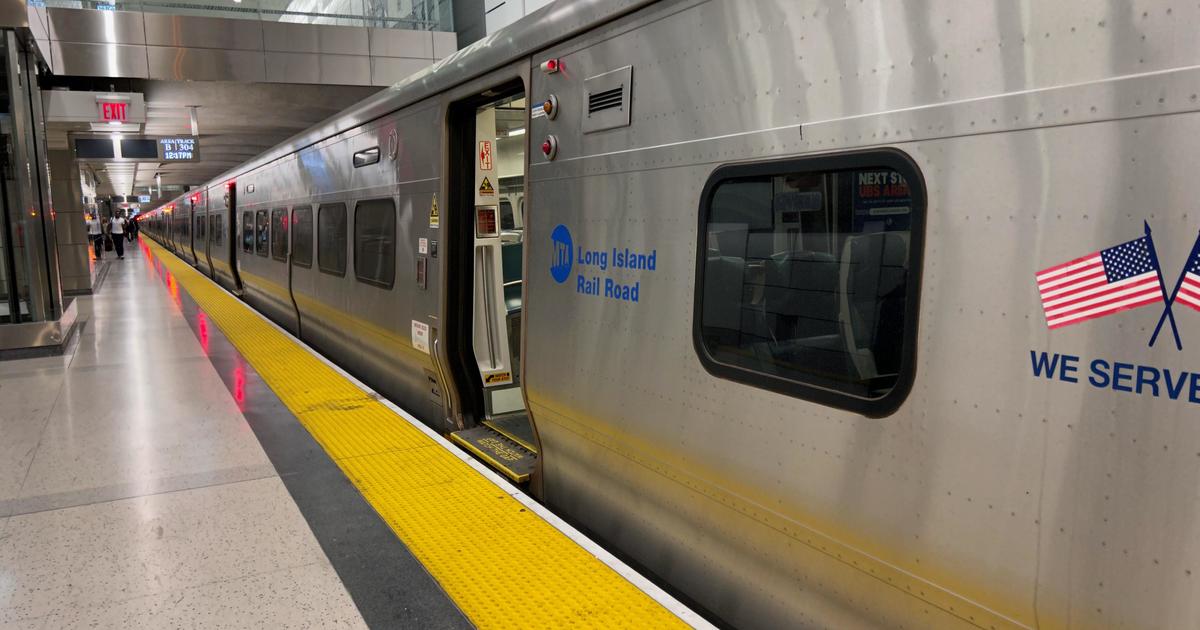
These riders could get a discount when NYC congestion pricing starts

Suspected killers indicted for chilling Long Island murders

Man wanted in felony assault shot, killed by police in NYC
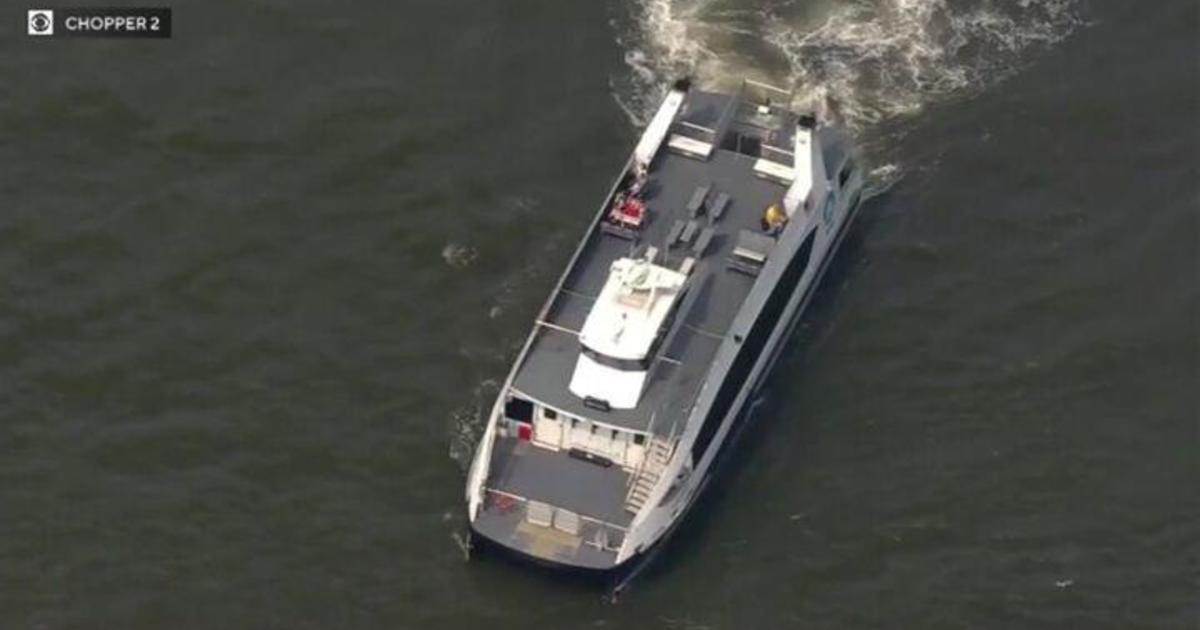
Lawmakers pushing for NYC Ferry route connecting S.I., Brooklyn
A Snob’s Guide to Egypt
You can’t fully escape the crowds descending on Egypt now. But, as always, there are strategies…
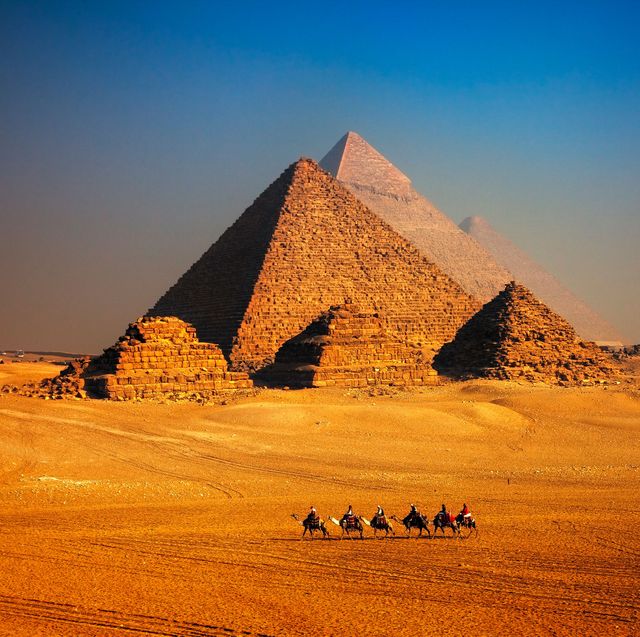
Every item on this page was chosen by a Town & Country editor. We may earn commission on some of the items you choose to buy.
Egypt gives us what no other country can: the chance to see up close, in situ, the astonishing creative impulses of the world’s most long-lived ancient civilization. If it’s your first time, you’ll want to concentrate on the historic must-sees. They are scattered the length of Egypt, mostly in the narrow band along the banks of the Nile. The classic itinerary is Cairo–Aswan–Nile cruise–Luxor, then back to Cairo. (The order of Aswan and Luxor can be switched, depending on which cruise you take.)
But Egypt has not been standing still. There are new museums. There is a fever of excavations, with new sites opening to visitors and others restored. And there are off-the-beaten-path places to explore, including the newly accessible Sahara oases (the desert makes up about 95 percent of Egypt’s territory and is another world). All that, however, requires that you extend your trip beyond the usual 10 to 12 days—or, unimaginably, skip one of the classic stops. Want a full day at the Old Kingdom necropolis of Sakkara, to see the new finds? You’ll need a third day in Cairo. Ditto if you’re a rider and want to spend an afternoon galloping on an Arabian horse around Sakkara and Giza.
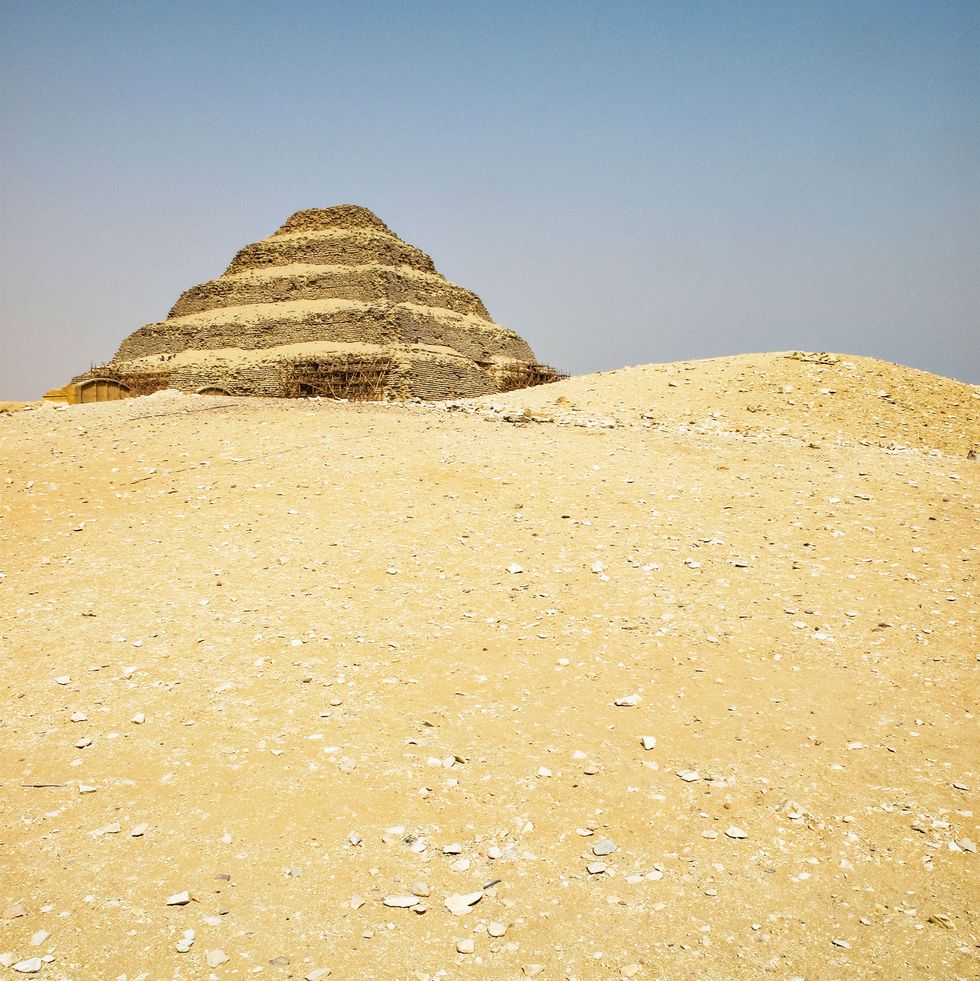
You need at least two days in Cairo, more if you can. To stay, I recommend the Four Seasons Nile Plaza , the Ritz-Carlton , and, if you don't mind a slightly more four-star place, the Marriott on Cairo's central, formerly chi-chi Zamalek Island, where I always stay; I like its convenient location, its Suez-Canal-related history, and most of all its large back garden and buzzy outdoor cafe, where tout le Caire still seems to congregate over hookahs and mighty strong G&Ts.
Devote the first day to pharaonic Egypt: the pyramids of Giza and the Sphinx in the morning, followed by the Memphis Museum and a walkabout of the vast funerary complex of Sakkara . On day two you’re in medieval Islamic Cairo: two mosques (the renowned Al-Azhar and the magnificently severe Ibn Tulun ), the Citadel (begun by Saladin to defend Cairo from the Crusaders), and an end-of-day meander (with shopping) around the Khan el-Khalili market —part tourist trap, part real thing. A third day can be some combination of the below:
Two museums: The National Museum of Egyptian Civilization , where the mummies now reside, and the Grand Egyptian Museum in Giza, a.k.a., GEM (which is not officially open but is partially accessible, for a range of high fees—and worth it).
A full day at Sakkara: See the pyramid of Unas and its exceptionally fine carvings of funerary texts; the mind-bending Serapeum , where mummies of the sacred Apis bulls were buried in giant sarcophagi; and the king’s burial chamber tunnels beneath Djoser’s newly stabilized Step Pyramid ; you can now gaze straight down at his sarcophagus. End the day at the rarely visited three main pyramids of Dahshur (the Red, Black, and Bent), seven miles south of Sakkara. This is what you want in Egypt: to see something no one else is seeing, alone with ancientness.
For $3,000 you can spend time alone in Sakkara's colorful, newly discovered tomb of Wahtye, a high-ranking priest from the 25th century BC—who possibly stole the tomb from his brother.
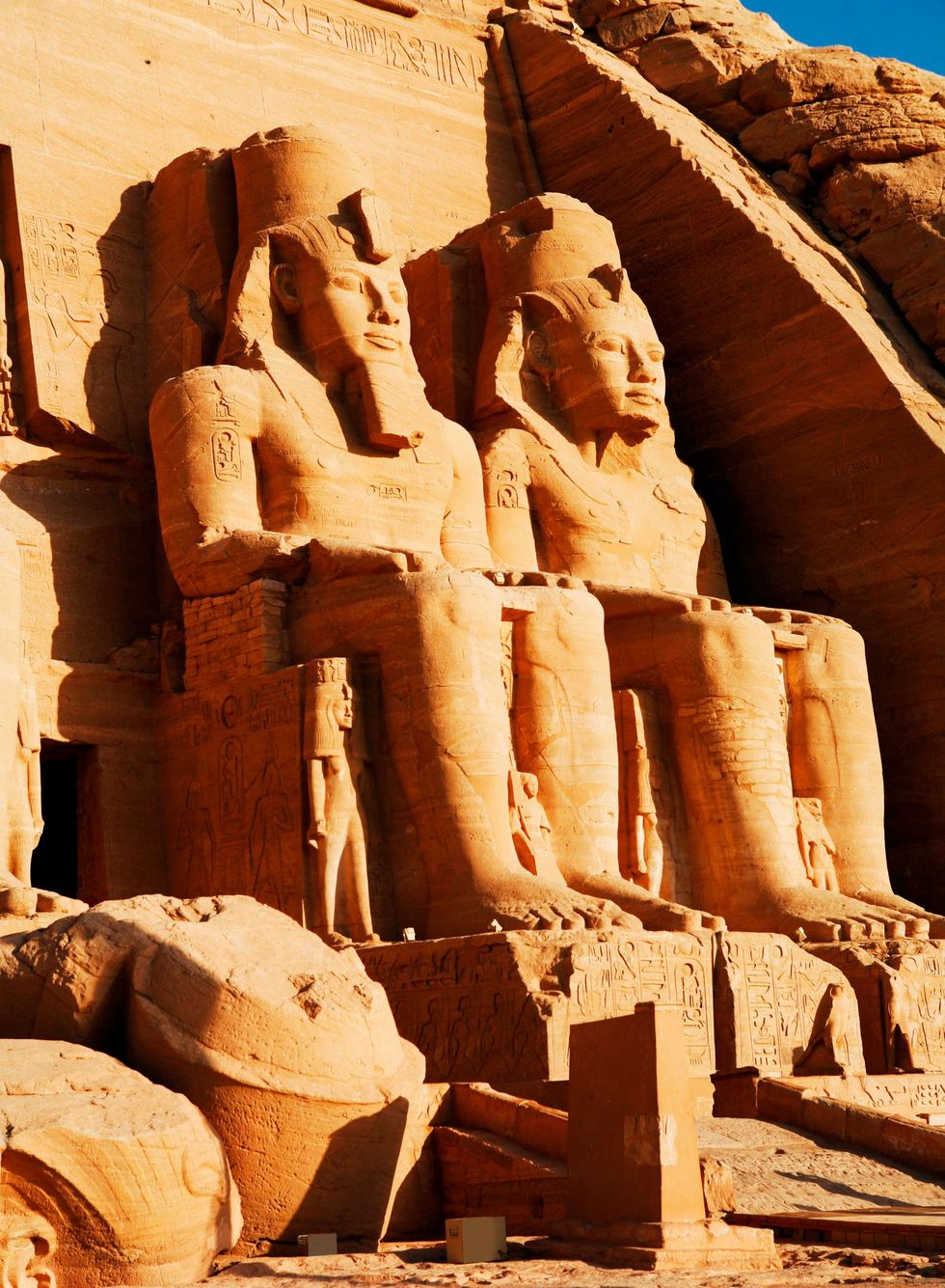
An early morning flight from Cairo to Aswan and a short connecting flight to Abu Simbel, near Egypt’s border with Sudan, puts you face to face with as great a play for immortality (and ancient geopolitical power) as the pyramids of Giza. Contemplate Ramses II’s two staggering temples , then board the short early afternoon flight back to Aswan and the luxuries of Sofitel Legend Old Cataract Hotel , with its ghosts of Winston Churchill, Agatha Christie, and many others—and the most perfect view of the Nile.

Aswan was always a frontier town, the last bastion of pharaonic religion, centered on the powerful cult of Isis worship in the temple of Philae . See the temple (it’s a tourist magnet, so go at dawn if possible), but even early travelers came here less for the antiquities than for the city’s tranquil “Nice of the Nile” beauty. Your next two days should include, between bouts of lounging, St. Simeon’s Monastery , in the desert on the opposite bank (the ancient Christian wreck has an oddly powerful aura); the elegant, eye-opening pink granite Nubian Museum (which presents the history and culture of Egypt’s ancient southern neighbor); Elephantine Island , a nexus of caravan routes from across Africa where you’ll arrive by felucca (an Aswan must); and a walk atop the Unfinished Obelisk , a fascinating ancient failure. Reputedly commissioned by the female pharaoh Hatshepsut, it would have been the world’s largest by far, but it developed fatal cracks. Its bottom end is still attached to the rock bed, workers’ marks still visible.
Foodie trove in the Aswan market: This small, manageable bazaar, which has rebounded in recent years, has the freshest, most varied spices procured directly from all over Africa. Stock up.
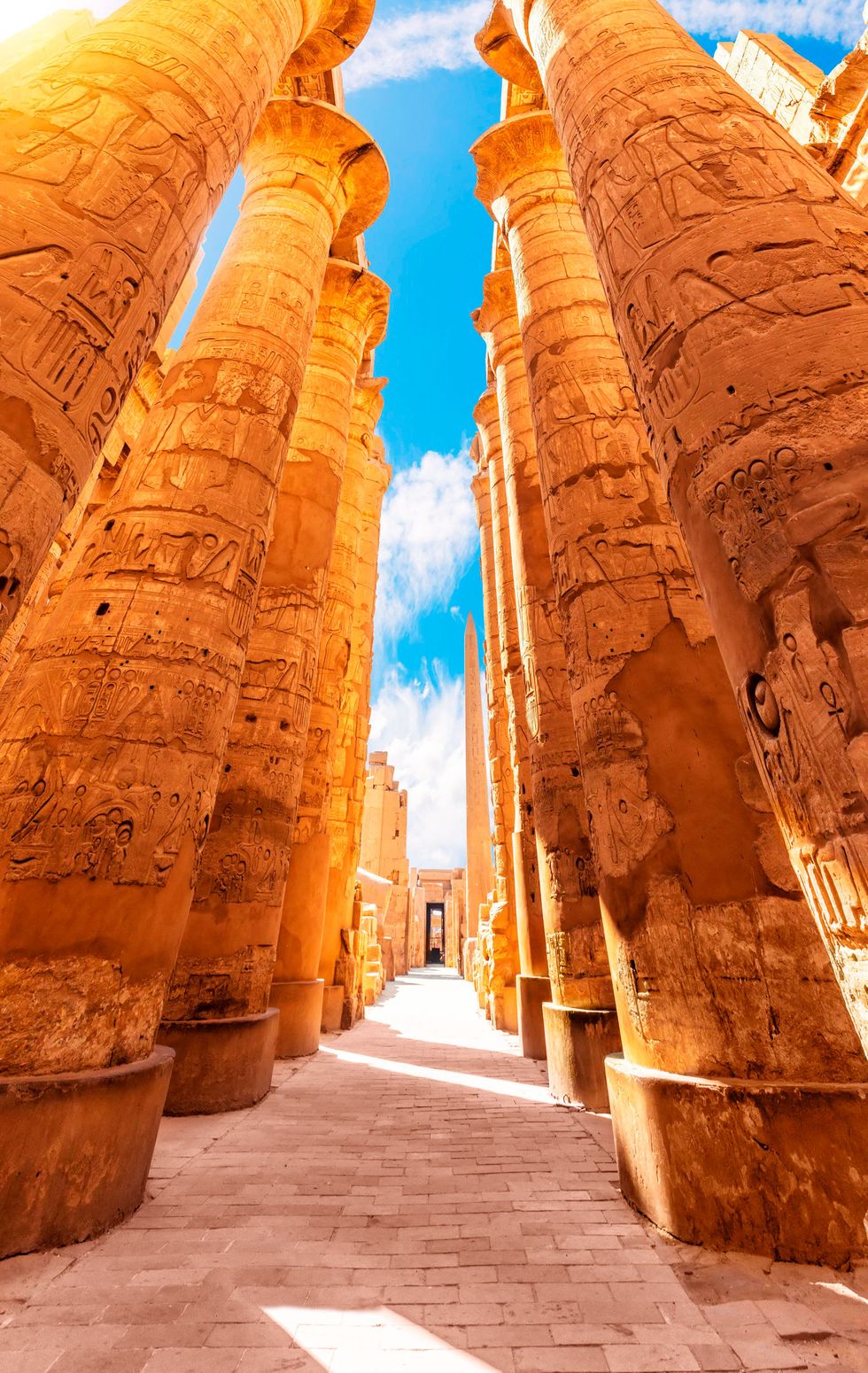
This is the mother lode of Egyptian antiquities, the country’s ceremonial capital for millennia. Stay at the grand but tatty Sofitel Winter Palace , overlooking the Nile on the east bank, or the boutiquey, just renovated Al Moudira , amid farmland on the west bank. Musts on the east bank, site of the ceremonial temples: the Karnak complex , the largest place of worship in the ancient world, and Luxor Temple . On the west bank, site of mortuary temples and tombs, get advance special entrance tickets (fewer visitors) for a handful of the best pharaonic tombs in the valleys of the kings and queens —especially those of Ramses VI, Nefertari, and Seti I. See the stunning Deir el-Bahri , mortuary temple of Hatshepsut, at dawn, as crowds truly interfere with sightlines. The Tombs of the Nobles offer a glimpse of how nonroyals lived and died. The temples of Medinet Habu and the Ramesseum are much less crowded; the shattered remains of Ramses II’s colossal statue in the latter are a reminder of how man’s best-laid plans can come to naught.
Avenue of the Sphinxes: It took 70 years to restore this ancient road, originally lined with 1,057 sphinxes and ram-headed statues, and you can now walk its entire 1.7 miles, from Karnak to Luxor Temple.
Temple of Khnum, Esna: The long-overlooked temple of the ram-headed god, 35 miles south of Luxor, where most dahabiya cruises (see below) start, got a pharaonic face-lift; its columns now burst with their original colors.
Luxor Temple is already resplendently lit at night. Now imagine a private dinner amid the forest of giant columns in its Hypostyle Hall. Jim Berkeley of DAI can arrange it for you.
Nile Cruise
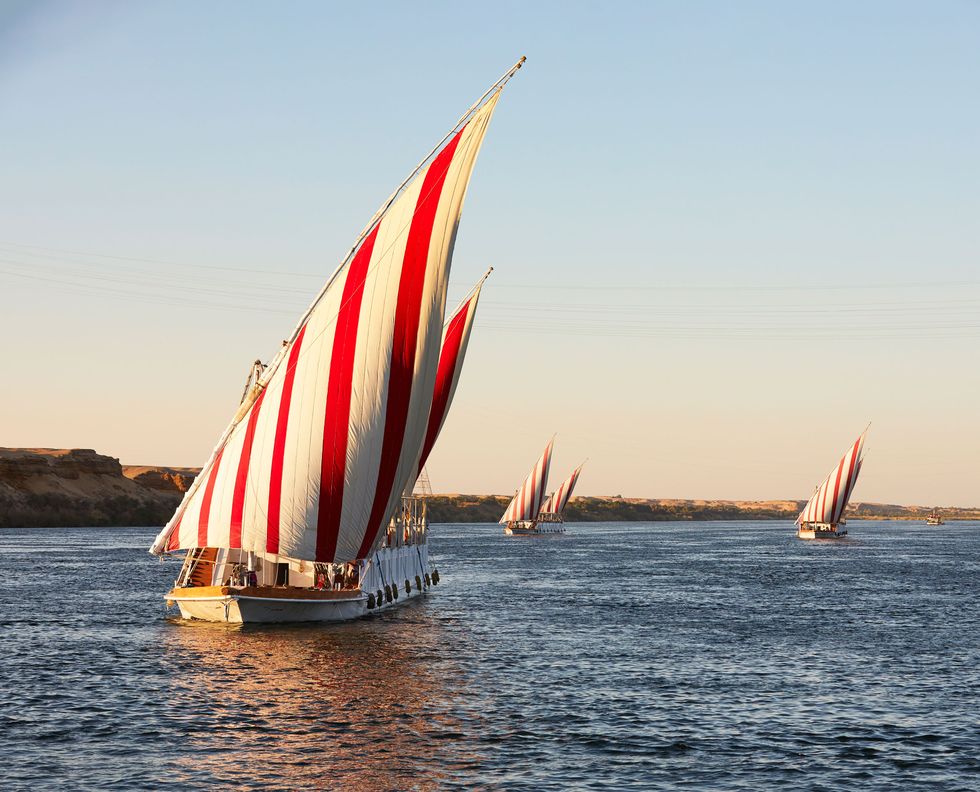
Do not, under any circumstances, be talked out of a Nile cruise in Upper Egypt. I resisted for a long time, but once I succumbed I found out what I’d been missing. You can cruise on a largish ship, with amenities like a plunge pool and spacious cabins (best choices would be Oberoi’s Zahra and Philae , or Egyptian-owned Historia ). Or, my preference: a traditional, flat-bottomed, two-masted dahabiya, with only eight to 12 cabins. Small cabins and bathrooms don’t matter, because you’re luxuriating on deck most of the time anyway, Agatha Christie–style, your hair blowing in the wind, a G&T in your hand, watching eternal Egypt pass by.
Consider one from chic Nour el Nil , which operates seven dahabiyas (the new Roman is the roomiest), or Zekrayaat , operated by Nile Dahabiya , or one from Lazuli Voyages . If you want total privacy, do a charter-only dahabiya, such as Zein Chateau , operated by A&K offshoot Sanctuary . Most commonly dahabiyas leave from Esna, south of Luxor, and sail four days upstream to Aswan. You can also board in Aswan and sail downstream, north to Esna—a shorter, 3-day voyage because of Nile currents. (How much time you spend on the boat will also determine in which order you visit Aswan and Luxor.) All ships stop at the temples of Kom Ombo and of Horus , at Edfu. But what only a dahabiya can offer is the ability to nose up to a pretty stretch of Nile shoreline and set up an impromptu picnic, after which you can walk to a nearby village where there are absolutely no other tourists.
Kazazian Cruises : It’s the striking new charter-only entrant in the Nile dahabiya competition. Their first boat can sleep 18, has a plunge pool on deck (as few others do), and has sleek all-white interiors.
Western Desert

Time in the desert gives any trip to Egypt an extra dimension. A vast region from west of the Nile to the Libyan border was closed for five years, because of instability in Libya, and only reopened recently. Fayoum oasis is just 69 miles southwest of Cairo, but it feels a world away: lush vegetation, waterfalls, a blue lake, rich birdlife (it’s on the migratory route between Africa and Europe). Fifty miles farther out is the Valley of Whales : gigantic fossils of whales and sharks from 40 million to 50 million years ago, when the Sahara was beneath the sea. (You will likely be alone.) Stay at the charming 16-suite Lazib Inn Resort & Spa , owned by a former VP of Four Seasons hotels.
Siwa oasis and its 40-room Adrère Amellal ecolodge , the inspired project of Cairo environmentalist and aesthete Mounir Neamatalla, require a 90-minute flight from Cairo or an eight-hour desert drive (which, believe it or not, has its charms). It is Egypt’s remotest oasis, a tropical garden of date palms, olive trees, and donkey carts, more than 200 freshwater springs, some hot, with the Great Sand Sea all around—the mammoth dunes of every Arabian fantasy, into which you can ride or drive. Visit the ruins of the temple of Amun , where Alexander the Great consulted the oracle in 331 BC after assuming the mantle of pharaoh, and the Mountain of the Dead , the startlingly beautiful graves of Siwa’s citizens going back to Greco-Roman times. Or just breathe, bathe, swim, and consume Adrère Amellal’s splendid organic meals—served at night by the light of hundreds of candles.
There is not more glamorous takeover than Adrere Amellal. You'll need a solar charger for your phone, but you can say you've done the "Sahara roller coaster" and slept where King Charles did.

Klara Glowczewska is the Executive Travel Editor of Town & Country , covering topics related to travel specifically (places, itineraries, hotels, trends) and broadly (conservation, culture, adventure), and was previously the Editor in Chief of Conde Nast Traveler magazine.
@media(min-width: 40.625rem){.css-1jdielu:before{margin:0.625rem 0.625rem 0;width:3.5rem;-webkit-filter:invert(17%) sepia(72%) saturate(710%) hue-rotate(181deg) brightness(97%) contrast(97%);filter:invert(17%) sepia(72%) saturate(710%) hue-rotate(181deg) brightness(97%) contrast(97%);height:1.5rem;content:'';display:inline-block;-webkit-transform:scale(-1, 1);-moz-transform:scale(-1, 1);-ms-transform:scale(-1, 1);transform:scale(-1, 1);background-repeat:no-repeat;}.loaded .css-1jdielu:before{background-image:url(/_assets/design-tokens/townandcountrymag/static/images/diamond-header-design-element.80fb60e.svg);}}@media(min-width: 64rem){.css-1jdielu:before{margin:0 0.625rem 0.25rem;}} In the Magazine @media(min-width: 40.625rem){.css-128xfoy:before{margin:0.625rem 0.625rem 0;width:3.5rem;-webkit-filter:invert(17%) sepia(72%) saturate(710%) hue-rotate(181deg) brightness(97%) contrast(97%);filter:invert(17%) sepia(72%) saturate(710%) hue-rotate(181deg) brightness(97%) contrast(97%);height:1.5rem;content:'';display:inline-block;background-repeat:no-repeat;}.loaded .css-128xfoy:before{background-image:url(/_assets/design-tokens/townandcountrymag/static/images/diamond-header-design-element.80fb60e.svg);}}@media(min-width: 64rem){.css-128xfoy:before{margin:0 0.625rem 0.25rem;}}

This Is What Happens When a Jewelry Icon Evolves

Roman and Williams Celebrates T&C's April Issue

Anatomy of a Classic: Il Bisonte's Consuelo Bag

The T&C Investment Portfolio: Home Edition
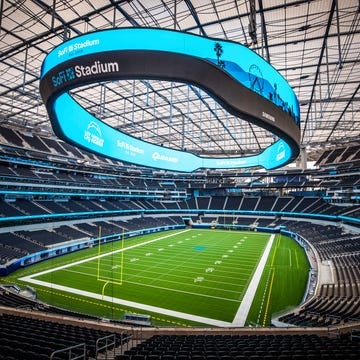
Why Billionaires Are Buying Up Sports Teams

Sanderson Launches New Home Collection

Did Marie Antoinette Have the Best Bed in Europe?

The Dawn of the Dumb House

Investment Portfolio April 2024: Wedding Edition

Zoe Otedola & Cole Weston's Bucolic Wedding

The New Must in Wedding Prep: An Insta Makeover
These 5 Arizona hotels were just named among the world's best. Here's why they stand out

Five Arizona hotels were just named among the best in the world for 2024.
Travel + Leisure unveiled its 2024 T+L 500 list of the world's best hotels, compiled based on ratings from its readers, in its May issue. The list includes five Arizona hotels, including four that made T+L's 2023 best hotels in Arizona ranking .
Readers evaluate based on their levels of quality, luxury, service and amenities. Here's a look at which Arizona hotels made the Travel + Leisure 2024 best hotels list.
For more hotels recognized as being among the best of metro Phoenix, read about the honorees in U.S. News & World Report's 2024 ranking , Forbes' 2024 Star Awards , and Esquire's best new hotels in the world .
Five Arizona hotels selected by Travel + Leisure
Readers of Travel + Leisure, America's largest travel media brand, selected five Arizona hotels on its 2024 ranking of the world's best hotels:
- Castle Hot Springs, Morristown.
- The Hermosa Inn, Paradise Valley.
- Mountain Shadows Resort, Paradise Valley.
- Sanctuary Camelback Mountain, A Gurney's Resort & Spa, Paradise Valley.
- Tanque Verde Ranch, Tucson.
“We’re honored to be recognized on the highly coveted T+L 500 List,” said Andrew Chippindall, general manager of Mountain Shadows Resort. “It’s a true testament to our team’s unwavering commitment to providing exceptional experiences for our treasured guests.”
How Travel + Leisure World's Best hotels 2024 were chosen
The T+L 500 list is derived from T+L's annual World's Best Awards, selected based on reader reviews and feedback. Readers were surveyed about their travel experiences around the world, including hotels, cities, islands, airlines, cruise ships and other experiences.
Readers rated hotels based on their rooms and facilities, location, service, food and overall value. They scored each category on a scale from "excellent" to "poor."
The hotels recognized this year are favorites among the publication's readers, who named Castle Hot Springs the best Arizona hotel of 2021 and 2022 and the Hermosa Inn the state's best of 2023. All except for Tanque Verde Ranch were included on last year's list of the 10 best hotels in Arizona.
Michael Salerno is an award-winning journalist who’s covered travel and tourism since 2014. His work as The Arizona Republic’s consumer travel reporter aims to help readers navigate the stresses of traveling and get the best value for their money on their vacations. He can be reached at [email protected] . Follow him on X, formerly Twitter: @salerno_phx .
Support local journalism. Subscribe to azcentral.com today.

IMAGES
COMMENTS
Travel. Leisure tourism, a popular form of travel, refers to the act of taking a trip for the purpose of relaxation, recreation, or enjoyment. It involves participating in activities typically done during one's free time, such as sightseeing, shopping, dining out, and engaging in cultural events. While leisure tourism can take many forms, it ...
Leisure travel is travel undertaken for pleasure or relaxation. It is a type of tourism that is distinct from business travel, which is undertaken for work-related purposes. Leisure travel can take many forms, from a weekend trip to a beach to a multi-month backpacking expedition.
Leisure tourism: This involves traveling for recreational purposes, such as beach vacations, adventure trips, or visiting theme parks. Cultural tourism: This focuses on exploring the heritage, customs, and traditions of different cultures, including visiting museums, historical sites, and attending cultural events.
The main difference between leisure and tourism is that leisure is an activity that individuals engage in during their free time, while tourism involves traveling to new places and experiencing new activities. Leisure activities can be done at home or within one's local community, while tourism requires leaving one's home environment.
Leisure tourism is a broad category that can encompass many different things: adventure tourism, ecotourism, cultural tourism, urban tourism, and more. Leisure tourism is simply defined as tourism during your free time, in which you relax and experience a different environment than your own.
tourism, the act and process of spending time away from home in pursuit of recreation, relaxation, and pleasure, while making use of the commercial provision of services.As such, tourism is a product of modern social arrangements, beginning in western Europe in the 17th century, although it has antecedents in Classical antiquity.. Tourism is distinguished from exploration in that tourists ...
As corporate and leisure travel have both bounced back after the COVID-19 pandemic, companies, travelers, and the travel industry itself are all figuring out how to navigate the "new normal" in the travel world, which includes concepts like revenge travel, the return of meetings and large events, a major focus on sustainable travel, and a particular concept we'll focus on with this ...
Leisure travel. Leisure travel generally refers to travel that is undertaken for the purpose of pleasure, enjoyment, relaxation or special interests. Leisure travel is an important component of tourism, and makes up a significant part of the tourism industry. There are different ways that someone can undertake leisure travel.
Experiences are popular commodities in the tourism industry (Knobloch et al., 2017), as offerings in this domain are typically experiential.Creating a memorable tourism experience is a primary management objective (Lemon & Verhoef, 2016), particularly in the sustainable tourism domain.One important reason that tourism experience is valued is that it involves interactions with people, products ...
Tourism, as a form of leisure experience, produces positive emotions but how such emotions link to aspects of the tourist experience is largely unknown. Nawijn et al. ( 2012) found that individuals on 1- to 2-week vacation experienced substantial emotional changes over their trips.
While tourism is the all-encompassing umbrella term for the activities and industry that create the tourist experience, the UNWTO (2020) defines travel as the activity of moving between different locations often for any purpose but more so for leisure and recreation (Hall & Page, 2006). On the other hand, hospitality can be defined as "the ...
U.S. Leisure Travel Is Back at Pre-Pandemic Levels for the First Time. 2 minute read. Tourists at a near-empty Patong Beach in Patong, Phuket, Thailand, on Monday, July 19, ...
While tourism is the all-encompassing umbrella term for the activities and industry that create the tourist experience, the UNWTO (2020) defines travel as the activity of moving between different locations often for any purpose but more so for leisure and recreation (Hall & Page, 2006). On the other hand, hospitality can be defined as "the ...
Pleasure is defined as a feeling of happiness, satisfaction, or enjoyment. Therefore, the pursuit of such feelings through travel is referred to as pleasure tourism. According to Currie ( 1997 ), "tourism" means pleasure travel, and according to the UNWTO ( 2007 ), pleasure represents the main purpose of tourism.
Leisure is an essential aspect of tourism that cannot be overlooked. It is the time that tourists spend engaging in activities that are not work-related but rather for pleasure, relaxation, and enjoyment. Leisure activities in tourism can range from sightseeing, hiking, camping, swimming, shopping, and many more.
Leisure tourism spending worldwide from 2019 to 2022 (in billion U.S. dollars) Leisure travel generates approximately 80 percent of global travel and tourism expenditure. While spending on ...
The World Tourism Organization defines tourists as people "traveling to and staying in places outside their usual environment for not more than one consecutive year for leisure, business and other purposes". [28] The World Health Organization (WHO) estimates that up to 500,000 people are in flight at any one time.
The U.S. Travel Association released its biannual forecast for travel to and within the United States through 2026, showing a normalized rate of growth in the domestic leisure travel sector after months of elevated demand. "Robust domestic leisure travel demand has been the driving force in the overall industry's post-pandemic comeback," said U.S. Travel Association President and CEO ...
What is Leisure Tourism? Definition of Leisure Tourism: Leisure tourism refers to take a break from daily routine life. Leisure tourists usually enjoy beauty and nice hotels and resorts, enjoy atmosphere of beaches. The most popular activities of leisure tourism include social tours, cultural tours, religious tours, family tours, sports tours, and medical tours.
Travel + Leisure's editors pay close attention not only to the latest in popular destinations but also to industry-wide trends like the growth of peer-to-peer rental services (such as Airbnb), new ...
Bleisure travel essentially involves two trips in one, which can present a packing challenge. Select versatile and comfortable wardrobe pieces that transition from the boardroom to a leisurely walking tour (like these editor-tested travel pants ). Sticking to a cohesive color scheme, a proven travel tip, can save space in your luggage.
getty. Bleisure travel, combining business and leisure, is on track to take over traditional business travel. The change creates a new type of traveler who is neither a business traveler or a ...
Leisure travel typically refers to a vacation-type trip that's taken in one's free time and for one's own pleasure and entertainment. It can be done with the family, with a partner, with friends, or alone. Leisure travel usually includes various pleasurable activities such as sightseeing, relaxing on the beach, experiencing local ...
Here's what you need to know to plan a trip to Richmond, Virginia, including the best hotels, restaurants, and more.
NEW YORK-- Travel + Leisure magazine's annual list of the 25 best beaches in the U.S. includes a pair of popular ones right here in New York City. The two beaches are sharing the prestigious space ...
Aswan was always a frontier town, the last bastion of pharaonic religion, centered on the powerful cult of Isis worship in the temple of Philae.See the temple (it's a tourist magnet, so go at ...
How Travel + Leisure World's Best hotels 2024 were chosen. The T+L 500 list is derived from T+L's annual World's Best Awards, selected based on reader reviews and feedback. Readers were surveyed ...
Travel + Leisure in an unsigned statement to Orlando Business Journal confirmed it is considering downtown Orlando among its options for a new home, as its lease at its current home on Sea Harbor ...